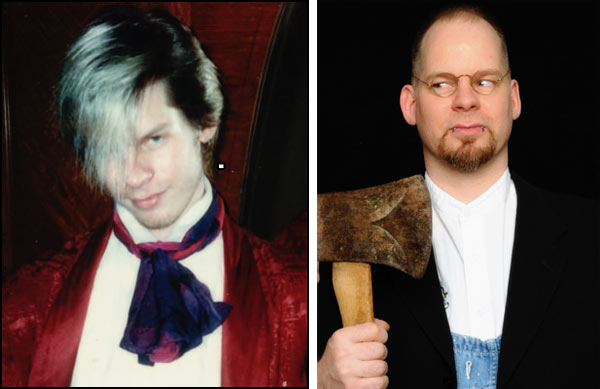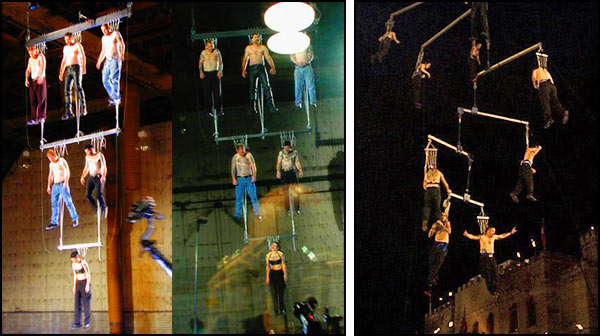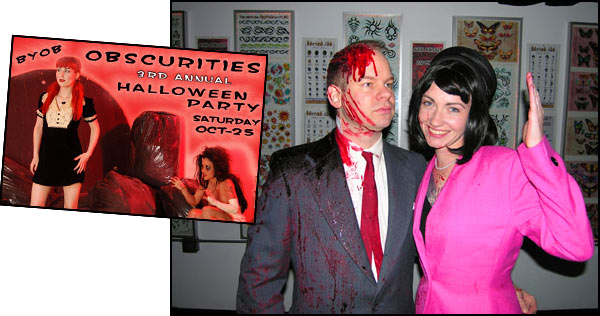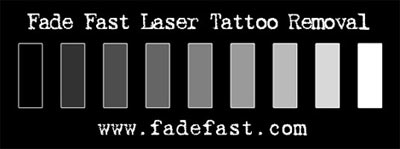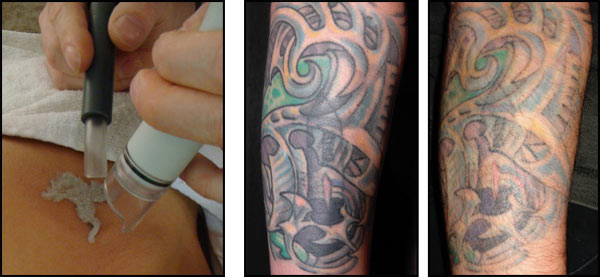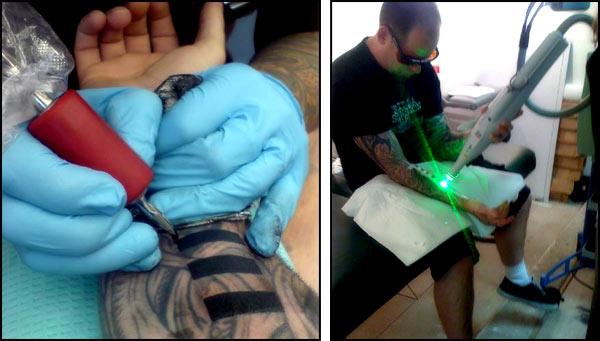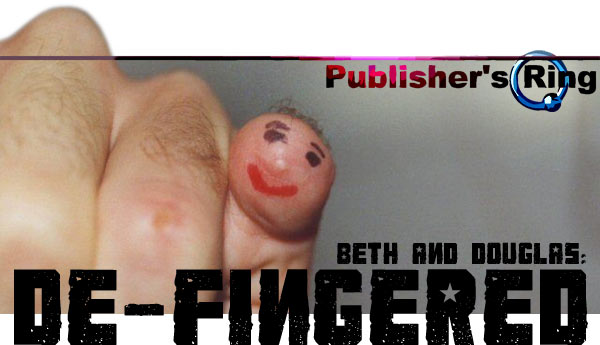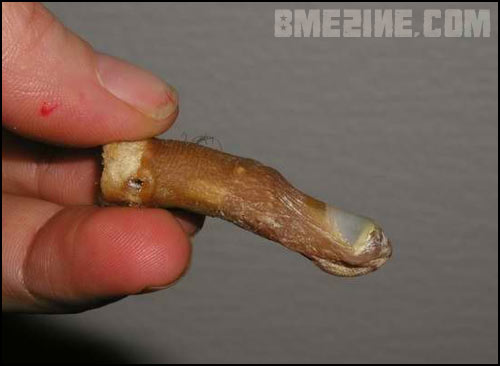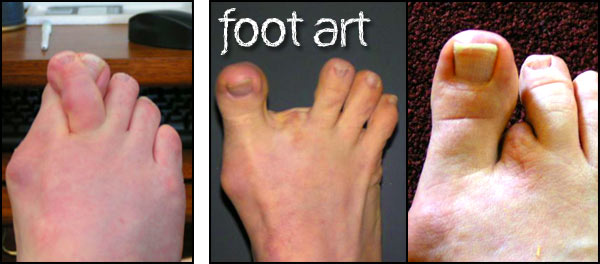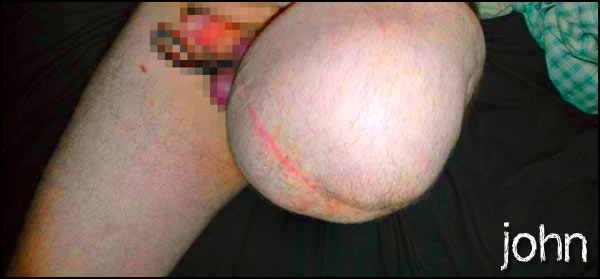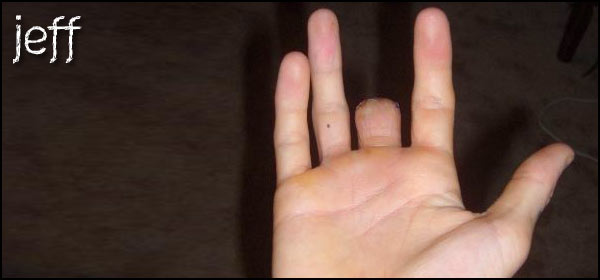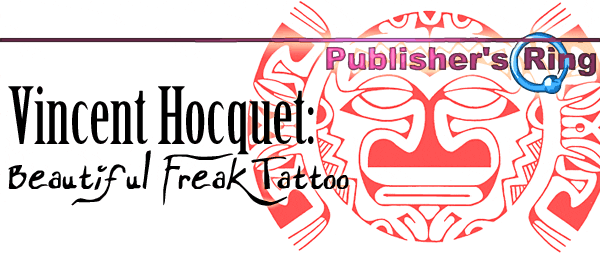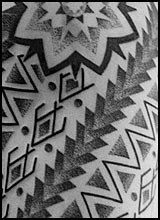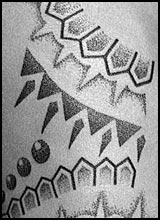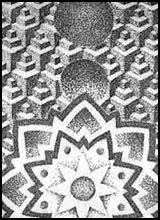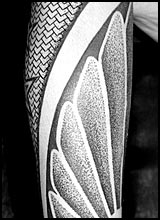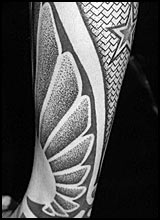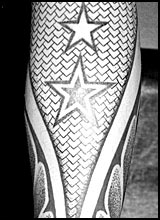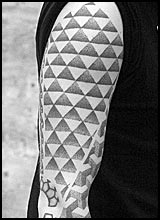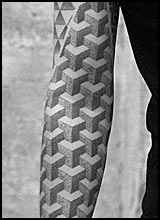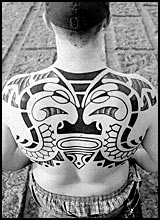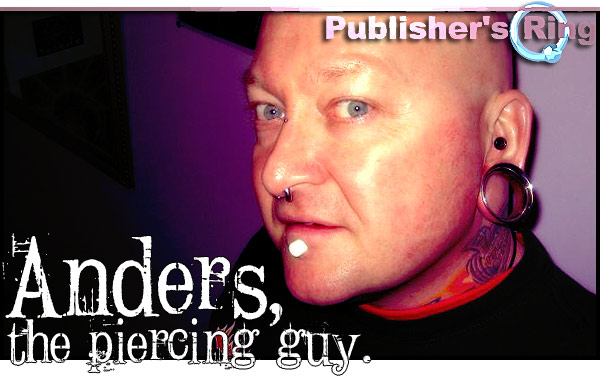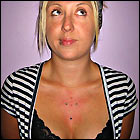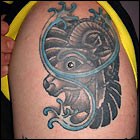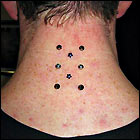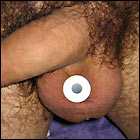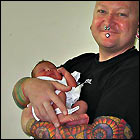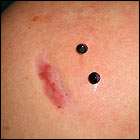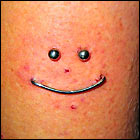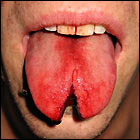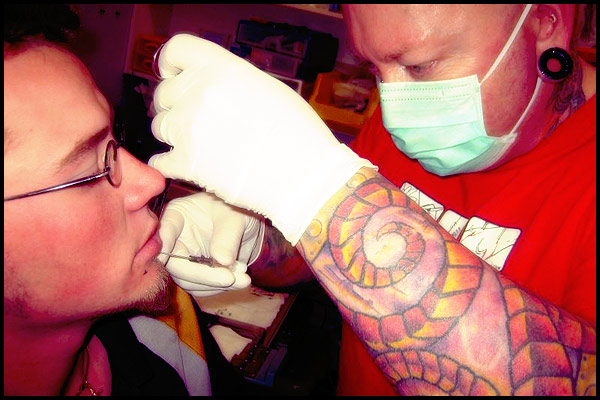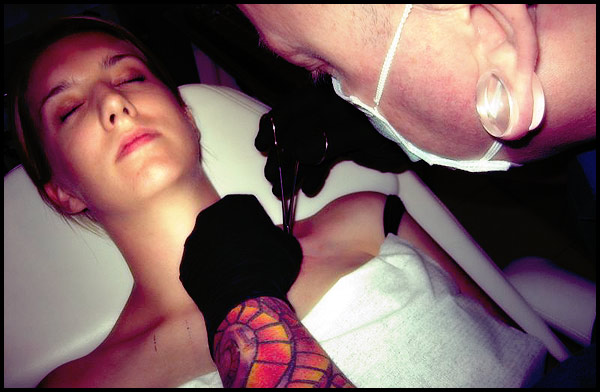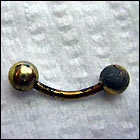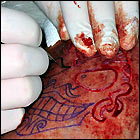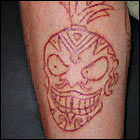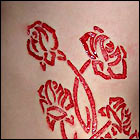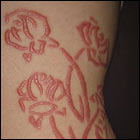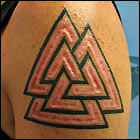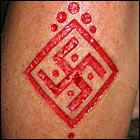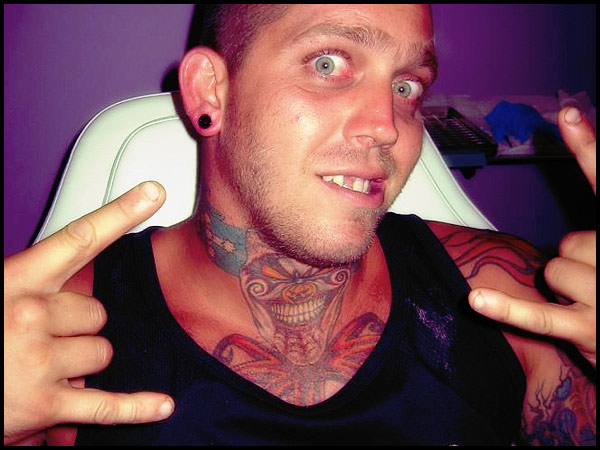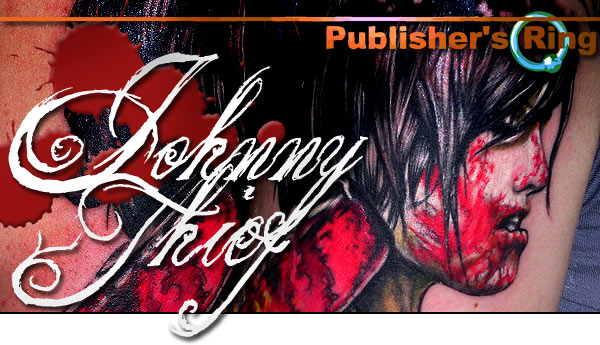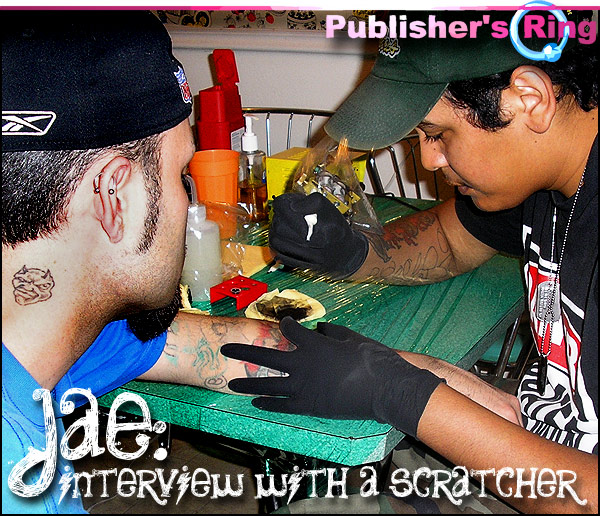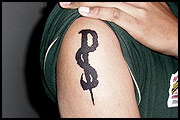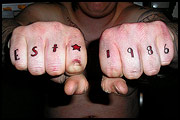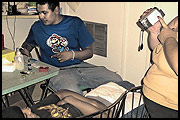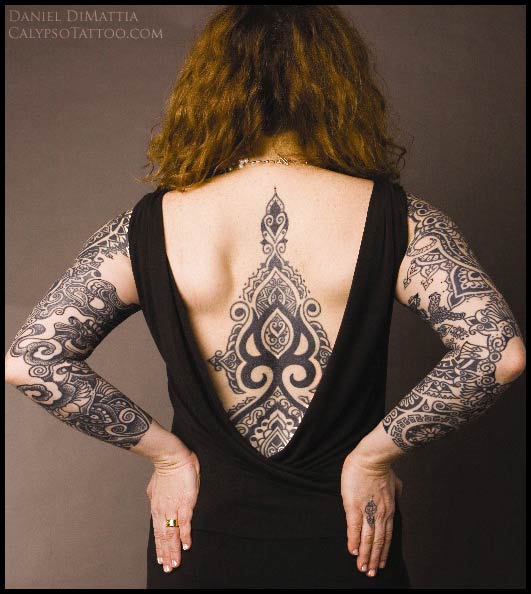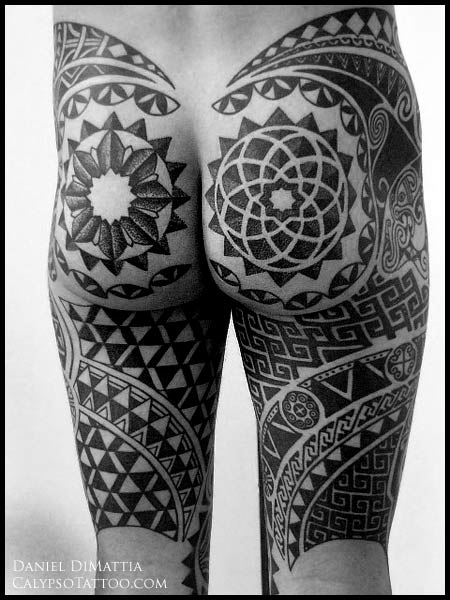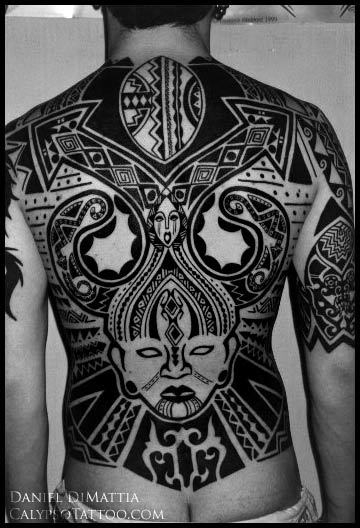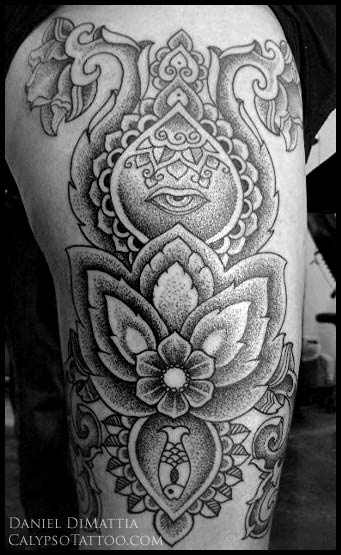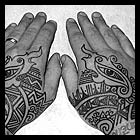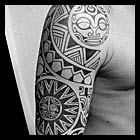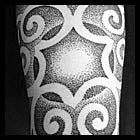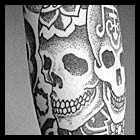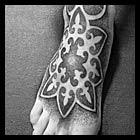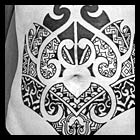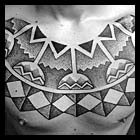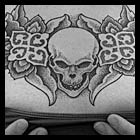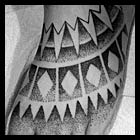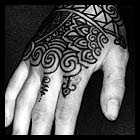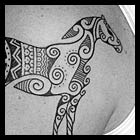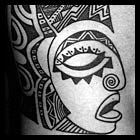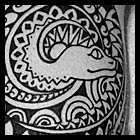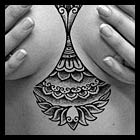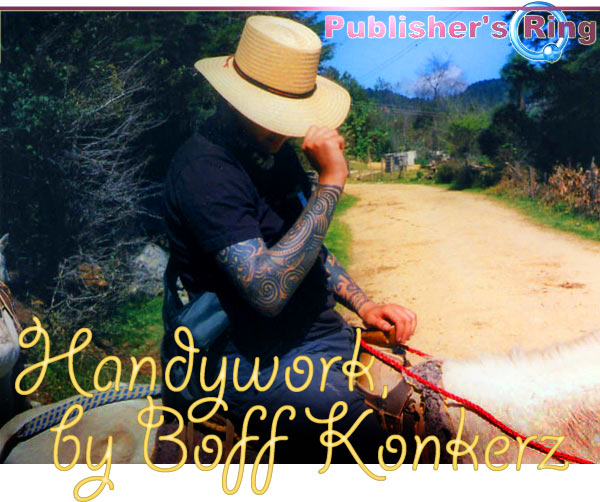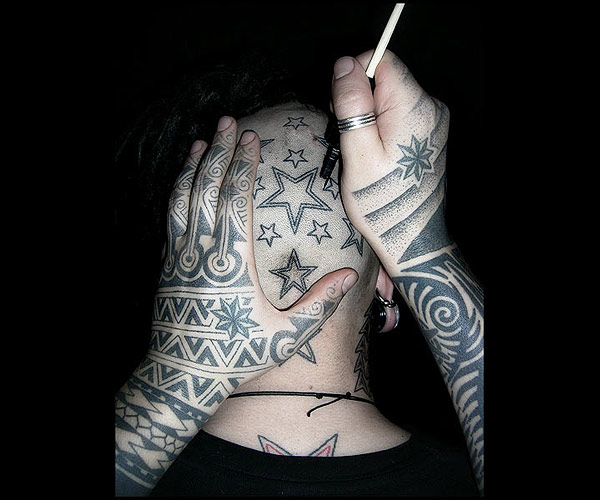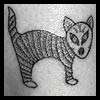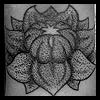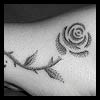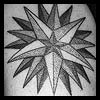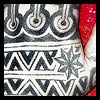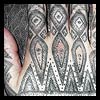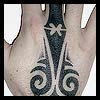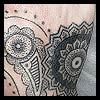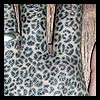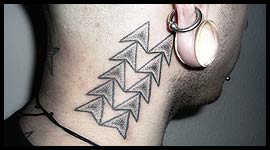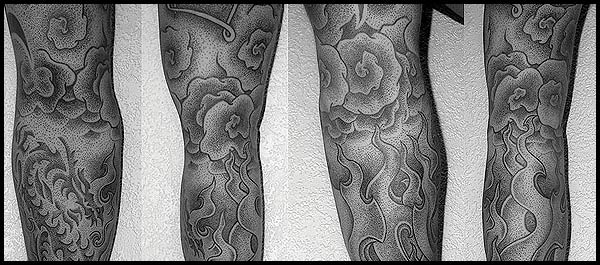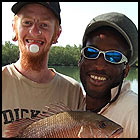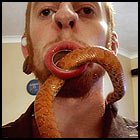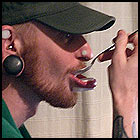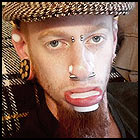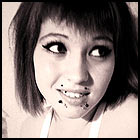|
Allen Falkner (and TSD) is probably best known as, along with Fakir Musafar, the singularly most influential suspension artist in the modern world (see his site, suspension.org) — a vast majority of similarly influential artists credit him as their inspiration and how they were introduced to suspension. In addition, he’s an accomplished piercer and body modification artist, and until recently, the owner of the decade-and-a-half old and consistently successful Dallas piercing studio “Obscurities“. He’s now retired from performance suspension (although he still works behind the scenes and facilitates suspension for others) and in addition to his work as a photographer, he’s opened a new business, “Fade Fast“, which offers tattoo removal with the intention of helping people improve their artwork through cover-ups and touch-ups rather than eliminating tattooing from their lives. In this interview he reflects on his suspension career, studio ownership, and talks about his feelings about tattoo removal. Note: If you haven’t already heard it, you may also want to download this older MP3 audio interview with Allen Falkner from May 2000, the tenth broadcast of BMEradio.
BME: How and when did you get started in suspension? Strangely enough, the performances came before suspension. I was involved in performance art as far back as the mid to late eighties. My initial interest and involvement in suspension, which was far more ritualistic, didn’t actually happen until ’92. Even then, hanging didn’t become a part of my performances until ’95. For me, the first three years of suspension were purely experimental and soul searching. It wasn’t until I met several other like-minded people and formed TSD that suspension started playing such a crucial role in my public/performance life. BME: How were you involved with performance art in the mid 80s? Strangely enough my first experience with performance art was also my first business venture. Back 1987, my friend Damon Law and I started a graphic design company called Baffle Logic. I think the original idea was to promote Damon’s artistic ability and to generate business designing print ads. You see, this was before inexpensive desktop publishing programs were available and not many people were on the Internet. So, the flyers were simple photocopies of designs that were all drawn up and laid out by hand and our contact info was a PO Box. At the time we were eighteen, couldn’t get into any bars, and I was straight edge anyway. So, passing out the flyers in the nightclub area was our entertainment on Friday and Saturday nights. At first Damon designed flyers that were purely artistic, but soon they changed to pseudo propaganda leaflets that were riddled with bizarre disinformation. Our nights of distributing flyers turned from a simple PR plan to a strange sort of street performance where we started saying a number of different odd things to people so they would take the flyers. In the end, nothing ever became of Baffle Logic — Damon went on to become a musician and a graphic designer (theStark.com and damonDesign.com) and my experience not only peaked my interest in performance art, but it was the beginning of my career as an entrepreneur.
BME: How many shows have you done — and how many people do you think you’ve brought into suspension? Nearly everyone in the intial suspension “boom” in the late nineties cites you as an influence. I’ve actually lost track of how many suspensions I’ve done; private, public and performance. These days I like to look at it in terms of places. Without creating a list of states and countries, I can say I’ve hung on every continent except Africa and Antarctica. It is still my hope to hang in Africa, and crazy as it sounds, hanging at the South Pole is one of my goals to do before I die. There’s no good rhyme or reason, and there won’t be many people to see it, but as silly as sounds it’s just something I feel compelled to do one day. As for bringing other people into the suspension, wow, no clue. It has always been my stance that suspension information should be available to everyone. Over the past fifteen years I’ve tried to help anyone that has asked for it. Not only does this make it difficult to give any kind of number, but I know for a fact that many people I have influenced have gone on and done the same thing. Directly or indirectly I know I’ve brought in more people than I can count. BME: What made you decide to leave performance suspension? Is this just as a performer (ie. will you still be doing “production”), or are you completely leaving? The decision to quit performing was very difficult, but it was time. Back in the day it was amazing just to see someone hang from hooks. Nowadays, you need to do something really impressive and unfortunately I made a niche for myself by doing cutaways and falling onto hooks. It’s a pretty impressive stunt, and it’s murder on my body, but it’s more than that. My final decision to quit actually came while performing in Greece last year. During my show, I pulled a muscle in my lower back. I was in pain for a week straight, sleeping on a friend’s couch in London and trying to recuperate for the show I had booked the following weekend. During that time I had plenty of time to think. The conclusion… my body just doesn’t heal like it used to and it’s better to just quit now while I’m at the top of my game. As for my future, I’m sure I will stay involved in performance suspension on some level. I still have some ideas I would love to see happen. So, yes I may very well keep working on the production side. Another reason why I want to quit is that there are just too many jobs for one person to do. When I’m on tour, I have no crew. So, teaching local people to throw strange hooks and handle rigging can be a bit disconcerting. I think doing more behind the scenes work would be much less stressful and then I could truly be involved in the safety side suspension performance, an area that is always hard to manage when you’re the one hanging.
BME: Looking back on your performance career, what shows are you most proud of? That’s tough to answer because for the time, each performance was very cutting edge. For instance, the nine-man mobile — theatrically not a very interesting piece, but the engineering behind it was incredible, especially for a bunch of kids from Texas. I think my favorite performance is still the “Hurt” show, named for Johnny Cash’s rendition of Nine Inch Nail’s “Hurt” that I use. I have done several different versions of the piece but the song always plays an integral part and sets the stage for a cutaway drop onto another set of hooks. The reason I’m so proud of the piece is that it’s unique and still rarely duplicated. BME: As a performer and artist, who have been your favorite people to work with? Who do you think is doing the most interesting suspension shows these days and why? As life experience goes, the people I’ve met and worked with while suspending have been inspirational. I hate to make a list of people because I know I will leave out so many but the top of my list are definitely Ron Athey, Lucifire and even Fakir, even if we don’t see eye to eye on many levels. In suspension performance there are too many to name but I will definitely mention Samar. She has been my performance partner off and on for a couple of years now and hanging with her is always so much fun As for suspension shows, I’m still a big fan of CoRE, but in all honesty, I rarely see other performance suspensions. I know the crew from Ascension performs regularly and I’m good friends with them, but I’ve never actually seen them on stage. For instance, I’ve seen Havve from Pain Solution perform a couple times, but I’ve yet to see a show that involves suspension, well, no live show. And I’ve seen Aesthetic Meat Foundation perform as well, but never any hanging. I have seen Operafication perform several times, but suspension is in my opinion a minor part of the act. The true focus is the singing not the hooks. I think the future of suspension will be more aerial work. I believe the Flying Tigers Circus were the first to incorporate suspension and trapeze work, but unfortunately the have retired the hooks as well. BME: Will you still do private suspensions for others? Oh yes, my focus on suspension has turned to the community, especially in the arena of education. I want to help others that are interested in suspension. That’s always been my primary goal and in many ways I feel that I got a bit lost in the performance side. For me, the act of hanging others has always been an amazing experience. To see some else hang is just as, if not more gratifying than doing it myself. I doubt very seriously that I will ever stop suspending other people. BME: Will you still do private suspensions yourself? Why or why not? Yes, of course. I still love private suspensions. In fact, all these performances have actually diluted my experience. I need to get back to me roots and just hang. When you are on stage, you need to worry about timing and music cues. When you hang just for you, you can just relax and immerse yourself in the sensation. BME: As one of the “fathers of the modern suspension movement”, and someone with a long history in both public and private suspension, what is suspension’s value? Heh, what value does any act have? For me, suspension is one of the most important finds in my life. For others, who knows? I have never been a big fan of pushing my ideals or beliefs on others, and in the case of suspension, this is most definitely true. So, rather than answering your question directly, I will answer it indirectly with another comparison. Smoking tobacco is socially acceptable. Annoying to some, a vice to others, but for most it’s just viewed as an activity that has little to no value. However to certain Native American cultures, the smoking of tobacco is part of an important ritual that has been passed down for generations. So, what is the tobacco’s value? BME: How is suspension different from self-harm? This question is difficult to answer in that everyone’s view of self-harm is different. Do the hooks hurt going in? Sure. Is hanging from hooks painful? A bit. So why do people do it? Simple, the sensation is amazing. Plus, many people have an experience that is life changing. Is it just a biochemical response to pain mixed with a euphoric sensation of getting close to shock while hanging feeling almost weightless? Do people have out of body or religious experiences? Is it just the fact that someone has just overcome their fears and done something that seems impossible? I really can’t answer these questions. Everyone gets something different. My personal view is that when we modify are bodies on any level we are putting ourselves back in touch with our tactile sensations. In western society we communicate with our outside world mostly through sight and sound. For some people, smell and taste play an important role as well, but what about touch? We, as a species, rarely use this sense. Other than sex, when is the last time you remember the sensation of what something actually feels like? Yes, suspension could be viewed as self-harm, but so could that ringing in your ears from all those loud concerts you attended. BME: You mentioned that it’s getting harder and harder to make an impact on a crowd with suspension. As a form of performance art, is suspension “done”? Not buy a long shot. In fact, I think quite the opposite. Suspension is actually an accepted art form now. With all the media hype and exposure, hanging from hooks has come out of the closet and entered mainstream conversation. It’s actually difficult to find anyone that’s never heard of suspension. Some of the old timers disagree, but I think this is a very positive thing. People may not be as shocked as they used to, but now hanging from hooks can be seen as entertainment. What role will suspension play in performance art in the future? Who knows. BME: I don’t suppose you could have imagined that suspension would be where it is now when you first started, and things have changed a lot in the last fifteen years. That said, do you think it will change much from where it is now, or has suspension hit a stable point socioculturally? I think everyone is pretty surprised at how far suspension has come. Just like piercing, when I first got involved I never really thought it would be much more than an underground activity. However, unlike piercing that has hit its peak and is now either stable or on the slight decline, suspension will never really gain much acceptance. I realize that it might seem pretty mainstream, but I doubt hanging from hooks will ever become the new navel. You never know though. There might be a future of “suspension spas” just on the horizon, but I definitely wont be behind that venture — but I will happily take a paid position doing guest lectures.
BME: Can you give me a really quick history of Obscurities?
I opened Obscurities as a piercing studio back in 1992, as hobby more than anything. In fact, the name came from only fifteen seconds of thought, and in some ways I regretted the decision because it’s difficult to spell and doesn’t really roll of the tongue. I was setting up the business, and didn’t even have a location yet, but I need a sales tax permit to be able to buy jewelry. I went to the county tax office to apply for it and realized I needed a company name for the document. I’ve always liked the word “obscure” because of its multiple meanings and how it can easily represent almost anything. So the word Obscur…ities just came out of my mouth when they asked for my business name. I planned to change it at some point, but a few months later I opened a piercing studio in a vintage clothing store. A year or so later the owners of that shop and I partnered to open the tattoo side, Trilogy Tattoo — there were three of us. A year later I sold my part to them. Then by 2000, the clothes were gone, it was one big tattoo and piercing shop, and I bought back Trilogy and combined it into one shop. BME: Was it difficult choosing to sell your shop after having it for so long? Difficult wasn’t even the right word. Gut wrenching is more like it. In all honesty I don’t think I would have ever sold it if the right person hadn’t come along and offered the right price — yes, money did play an important role. However, the sale was also based on the new owner’s character. If I thought for a minute he was going to tarnish the shop name or not take care of the employees it never would have happened. BME: It must be hard seeing “your baby” under someone else’s control? LOL, you don’t even know. Technically I only work as a consultant for Obscurities now, but I’m still in the shop every week. I know I haven’t really let go, and I’m not sure if I ever will. I am still emotional vested in that shop. I guess in a way it’s a good thing. What better than to have a former owner still supporting a shop that really gives him nothing? In a way it’s a huge compliment to everyone that works there. I still give praise to them all and consider it one of the best shops in the industry. BME: How have your feelings about the industry changed in any way, now that you’re not longer doing it for a day job? I’m not sure my feelings have changed, other than to say that I miss piercing a bit. I think the biggest difference now is that I can speak my mind, where before I was always afraid to bite the hand that feeds me. In all honesty, I think the biggest change is that no one is my competition anymore. When you work in any industry, especially if you own a business, there is a certain amount of “us against them” mentality. Now, I can walk into any tattoo or piercing shop and I feel welcome. Actually, even more than that, people now greet me differently. Now that I’m working in tattoo removal, artists are beginning to see me as an ally.
BME: Having now gone through the full cycle in this industry, would you do it over again if you could rewind to being, say, sixteen? Would I do it again? Of course! The last two decades have really shaped who I am. I can’t imagine what I would be like if I had finished my engineering degree. Yes, there are numerous things I would change if I knew then what I know now, but my general direction would have been the same. BME: You went to school for engineering? Prior to piercing I was a full time student and in my spare time I worked on several projects. I started a company doing a specialized form of tax filing. Yes, I come from a family of accountants. I worked in a movie theater, an art gallery, and even partnered with a guy to open an all ages club called the Discowtech one night a week at the gallery. It was actually my involvement in the club/gallery that led me to my first meeting with Fakir Musafar. He came to speak one day, took a shining to me, and I guess the rest is history. My education has always been a bit spotty. I was an exceptional student when I wanted to be, but more often than not I didn’t. In elementary and junior high I was an honor student, but high school was boring. So, I dropped out and got a GED. I became interested in computers so I went to college to get a degree in computer science engineering, but I discovered body piercing and chose to drop out. My father almost killed me. He put me through school and I quit to put holes in people. In the end, he was actually impressed by my accomplishments. He never liked my mods or the suspensions, but he was my accountant and did my taxes. He saw that I was a successful businessman and for that he was proud. BME: Did you ever consider going and finishing that degree? I think about it a lot, but it’s not the degree per say I want — it’s the learning and gaining of knowledge I crave. At this point in my life, a degree has little to no value to me. It’s simply a piece of paper. If I really wanted to get a degree I think an MBA would do me the most good, but I don’t really care enough to pursue it. Although I’m an entrepreneur at heart, the business classes I’ve taken just weren’t interesting enough and never seemed to apply to my businesses. I would rather sit in on lectures about quantum mechanics or human physiology. Oddly enough, I think most piercers, especially the old school ones, have a similar mentality. We just can’t conform enough to deal with the politics of the educational system, but on the other hand we are obsessed with self-improvement and learning. BME: Looking back, what moments do you most treasure in your experiences as a shop owner and piercer/body modification artist? I think I could write a novel answering this question. Off the top of my head, one my oldest memories is sitting in my shop, after closing. I was alone and it was dark except for the neon in the windows and the lights from the clubs outside. I remember sitting there thinking, “This is mine… I built this and I am proud.” As for experiences with clients, there are just too many to name. I constantly think I’m done, I’m retired, I’m through, but I have so many positive memories of piercings that I think about taking it up again. I really don’t think the answer to this question would be complete without a suspension experience. Again, there are so many things I could name, first tandem, first knee, first suspension, Night of 1000 Scars, but the nine man mobile really takes the cake. Besides pulling off an amazing engineering feat, the whole trip with I think 20 or 22 people, the largest membership of TSD ever, was an experience I will never forget.
BME: Is there any advice you’d offer to a piercer or tattoo artist that wants to also become a studio owner? What are some things you did right, and some things you did wrong? I could write a book about the dos and don’ts of being a studio owner, so I will try to pick a few highlights. As with any business it’s location, location, location. You can have the greatest shop in the world but you will never succeed if you are in the wrong area. If the studio is difficult to find, there’s no parking, or in an area that won’t attract your clientele, you will never make it. Stability is key as well. If your artists switch every few months you’ll never be able to keep a decent client base. People like a certain amount of change, but they want reliability too. Also, customer service seems to be a big problem for many studios. It doesn’t matter how good you are, people want to be treated with respect. Why some shops think it’s ok to grunt at and ignore customers I will never know. Last but not least, quality. If you offer shitty jewelry, your shop is dirty and your tattoo artists suck, you won’t be very successful. Strangely enough, the average customer cares more about everything I have listed above, over price, but people still feel the need to offer discounts and slash prices. This might be a good way to get people in the door, but if you offer a cut-rate price, people perceive you to be a low quality service. This last point leads to a good story. I know this tattoo artist that is such a good salesman. People would ask about a tattoo and he’d say something like, “You know the tattoo you want would look best with this ink.” Pulling out a random bottle he would say, “This ink comes from Tahiti and the color will really pop in your skin tone.” All along it was just regular bottle of ink. It didn’t really matter what kind of ink it was or where it came from, but he made his clients feel like he was giving them special attention. Even if this practice might not be the most ethical, people came back and loved him. Now, all that said, honestly, opening a new shop, with all the competition and the sluggish US economy, may not be the best decision. At the very least, a new shop needs to have some serious funding behind it… But good luck to anyone that tries. If you are looking for a consultant I am definitely available.
I always encourage people to lighten tattoos and recover them. Many tattoo removal clinics push total removal with the angle that getting a tattoo is a mistake. I feel very differently. It’s not that people hate tattoos — they are just unhappy with they have. As I try to explain to people, doing a few treatments and covering the old tattoo is usually the best option. Yes, total removal is sometimes necessary for certain career moves, but total removal is a big commitment. Using a laser to lighten existing work is cheaper, faster, and is better for the tattoo industry. I see it as a win-win situation for everyone. BME: What is your goal with Fade Fast? As I mentioned, using a laser to lighten tattoos is the perfect pretreatment to getting better artwork. Yes, I founded the business to help my clients, but it’s more than that. I am working directly with tattoo artists to fix, rework, and completely change their client’s tattoos. I know that some removal clinics are becoming more and more tattoo friendly. However, other than Fade Fast, I only know of one other company that works directly with artist to laser edit tattoos, Rethink Your Ink in Marion Illinois. BME: Realistically, what percentage of people eventually regret their tattoos? Regret? Well I don’t think anyone should regret any decision, but that’s not how most people see things. I think that people’s decisions to alter or remove tattoos have more to do with how their lives or ideas have changed. What was once a good idea may not be a good idea now. I would say that most people with multiple tattoos want to change them, whether it’s to remove, cover, or even add to them. As for true regret, it’s hard to say. Most people I work on say they regret their tattoo, but once I get them talking, more often than not, they don’t regret getting it, they just aren’t happy with what they have now. To me, this is more about perception. So with that said, 90? 95? 99? percent of people with multiple tattoos want something about their designs altered. True regret? Well, maybe tattoos that hinder their lives or remind them of an ex… but then again, aren’t those the things that have actually shaped their lives and made them who they are?
BME: As someone doing removal, what advice would you give to someone thinking about getting their first tattoo? Now that’s a loaded question. Should my answer be, go crazy and pay me to remove them in the future? As funny as that it is, it’s really not the answer. Yes, the technology is getting there, but removal is not a quick, simple process. Lasers are great tools for providing more options, but you can’t expect miracles. My real answer, “Think before you ink. How will this tattoo affect your future? Will it interfere with any future decisions? Make a plan. At eighteen you might not be thinking body suit, but at thirty will that tiny piece affect the flow of a half sleeve?” If there are any life lessons best learned early on, it’s that we all change. The more you plan and the better you prepare, the happier you will be. From a very early age I wanted hand and neck tattoos, but I got 3/4 sleeves and tried to be patient. At thirty-six, I had created a life and a career that allowed for my mods, so now my hands and neck are tattooed. Did I make mistakes? Sure, my back piece is a huge mess. I rushed into it, and now I’m a stuck with it. Will I remove it? Maybe… Who knows? BME: What kinds of tattoos are easiest and hardest to remove? Are different parts of the body different to do removal on? The technology of laser tattoo removal is based on light absorption. The darker the color, the more energy it will absorb and the easier it is to remove. Simple answer, but the problem is bit more complex. Different inks react to different wavelengths. Skin types and skin color also play an important role in laser removal. Plus, the quality of the tattoo is a key component as well as your immune system. The body’s lymphatic system does most of the work so each person varies dramatically. Generally poor quality, dark tattoos on high blood flow areas on light skinned people with strong immune systems are easiest to remove. Conversely, well-done, light-colored tattoos on people of darker skin in low blood flow areas of the body that might have slower healing are much more difficult. BME: How have your friends in the industry responded to your new business? For the most part I have been greeted very positively by most of my peers. However, I have had some very close friends react very negatively. I chalk it up to a misunderstanding and after a small discussion most people come around when they realize I’m in it to help the field of tattooing not hurt it. There are of course a few exceptions. I think laser tattoo removal and tattooing are complementary services and work great in the same location. However, one tattooer that is an old friend of mine still thinks the two do not belong in the same location. I guess we will just agree to disagree. BME: What would you say to people who believe that tattoo removal is fundamentally wrong or a betrayal to the tattoo industry? Not that I can imagine anyone with any sense or objectivity actually believes this? You would be surprised. I have found it to be a first reaction by some tattoo artists — not many, but it has happened. Usually I just explain who I am, my work in the industry, and how I see the laser as the perfect pretreatment for cover-ups. Nine times out of ten I get a very positive response, but there is always someone that thinks I’m Judas. In the beginning I was got very defensive, but now I just smile, shake their hand, and give them some promotional materials. BME: What do you think about the “easy to remove” tattoo ink that’s been in the media lately? Good idea or bad idea? How do you think that “easy” removal would change the tattoo industry and culture? I used to have mixed emotions about the Freedom-2 ink, but now I’m starting to think it’s a good idea and here’s why. No matter what ink you use, tattooing is still a long and painful process. I can see the modified culture not liking the fact that people can get a tiny tattoo and remove it a year later, but think about it this way. You sat under the needle to get it done. As far as I’m concerned you still “earned” the piece. So, yes, perception about small tattoos might change, but what about big work? What if you could spend ten, twenty, thirty plus hours on a piece and then remove all or part of it a few years later and start over? The impact on tattooing would be incredible. More work for artists, more modified people walking the earth, more social acceptance. “Oh that, I will get it removed later if I have to.” In the beginning there might be some disgruntled heavily modified people, but once the ink starts being used on a large scale, no one will complain. There will still be people that love tattoos and people that hate them. BME: Do you think tattoo artists should tattoo with removal in mind? Well, I don’t think my opinion matters, but I have never thought people should get tattoos done with the idea of removing them. Even if the ink is easier to remove, there is a permanence that is inherent with tattooing. I’ve always tried to consider the future in every decision, so in a sense, yes I’m sure some will tattoo with removal in mind. My guess though is it will be a small percentage. Tattoo artists are proud of their work and I can’t imagine many of them want their clients to remove their artwork. I do think there is one huge application that people are overlooking. Tattoo apprentices have to work on people. If they could work on clients with less worry of mistakes, wouldn’t inks like Freedom-2 be a huge asset? Plus, wouldn’t artists feel a bit less guilty about tattooing a piece of flash or name if they knew it could be removed later? BME: What sorts of changes have you observed in people via removal? That is, what sort of things do people usually get removed, and why? My business is different than most in that I work with heavily tattooed people. Many of many clients are clearing way for new work, so I spend a good portion of my time simply lightening dark areas. When it comes to the realm of total removal, you guessed it — the number one request is to remove names. Other removals have to do with placement. For instance I am removing a wrist tattoo on a woman that needs to hide it for work. Technically my job is tattoo removal, but I always try to encourage people to lighten and recover. In the grand scheme of things it means less treatments, faster results, and it helps people keep a positive attitude about their tattoos and the modified community at large. BME: Do you think this will in time become the norm? I can’t say if it will become the norm, but I do believe it’s the wave of the future. Complete removal is great and for some people it’s the best alternative, but for the modified community, laser removal will no doubt become a companion service to tattooing. So far most of my clients want entire pieces faded for complete cover-ups. However, I have been working with people to target specific areas just for the sake of editing the piece. BME: What equipment do you use, and what training was involved? I use two pieces of equipment. First is the Palomar Q-switched YAG laser. There are lots of lasers available and they all have their pros and cons. I decided to purchase this unit because it’s designed to work best on blacks and reds. Being that I focus heavily on lightening dark tattoos for re-cover, this laser is perfectly suited for my needs. Plus, it has a unique wave-blending feature that gives it enormous flexibility that no other system offers. Second, I use a Zimmer Cryo unit, which blows negative 22 degree air to keep the area cooled during the procedure. Blowing cold air on the skin isn’t necessary, but after polling multiple people that have experienced constant cooling during a removal treatment, I determined it was a good investment. Plus, when it’s used in conjunction with pre-icing the area, many people say the pain is comparable or even less than getting the initial tattoo. As for training, my initial education came from the National Laser Institute in Arizona. The school is definitely geared toward estheticians, but they also offered a course on laser tattoo removal. Then upon purchasing the laser, Palomar provided further training on the use of the unit. In all actuality, my biggest learning curve came from doing treatments on myself. I not only worked within the standard parameters of the laser, but I have and still continue to do tests to determine better methods to speed removal and to reduce the number of treatments.
BME: What “test” have you done and why? The main thing I have done is to tattoo nine black rectangles on the inside of my right arm, specifically to remove them. The first was not treated, the second treated once, the third twice and so on. I wanted a physical example of how the process works. Plus I wanted to show my commitment to the trade. How better to earn a client’s trust than to perform laser removal on myself first? I actually liked the image so much — I use it as my company logo. I now have four other tests in the works that I plan to start in the near future. Once I get each of them rolling, I plan to blog each of them step by step. BME: Are there any people you turn away? Actually, there are far more to turn away in this field than in a tattoo or piercing studio. As with any modification, I will not perform any laser treatment on clients that are on drugs or intoxicated. Plus, certain people either are not good candidates or simply cannot safely have laser treatments done. For instance, if the person has taken Accutane in the last year or are on any photo reactive medications there can be serious complications associated with the procedure. Also, there are numerous other factors to take into account. Were you aware that laser treatments can cause herpes flare-ups? The treatment area would have to be where the viral outbreak appears, but still, removing lip liner is a request I do get… bet you were thinking about different area, weren’t you? BME: How do you promote or market Fade Fast? I know that a lot of tattooing marketing involves word of mouth and handing out business cards, but I don’t imagine you walk up to people and are, like, “hey, your tattoo sucks — I can help you with that!” Funny that you say that, I see bad tattoos all the time, and yes I want to walk up and hand them a card, but how do you that? I think I’m pretty creative, and I’ve tried to think of a funny and non-insulting approach, but I have yet to figure it out. I do several things to market the business; print advertising, keeping a laser removal blog, bugging an old friend to do an article for BME, but my main marketing has been through local tattoo shops. I’ve been in the business so long that I know a good chunk of the artists that work in Dallas. So, my first plan of action was to go door-to-door, hand out promotional packs and simply tell everyone more about what I doing and why. It has actually been a very cool and educational experience. Back when I owned my studio I’d only been by a handful of local shops. Now I’ve seen the insides, artist stations, and even bio areas of eighty shops. Well, truth be told, only a handful of shops gave me the full tour, but still it was great seeing all those places. Although I do get business from all my PR work, my main referrals still come from tattoo shops. Shannon Larratt |
Category Archives: Features
Post navigation
De-Fingered: Finger Amputation Interviews in BME/News [Publisher’s Ring]
|
Yesterday we talked to a few individuals who “needed” amputations for primarily physical reasons, so today I’d like to chat to two people who chose amputation for purely psychological reasons, each choosing to self-amputate one of their fingers at home, disguised as an “accident”. Both of them did this privately and secretly, for themselves, so the pictures in the article are not actually of them. BME: Tell me about yourselves? Douglas: I am a thirty year old male from northern Europe, and I live in a small community with me wife and son. Beth: I’m completely sane, and to all intents and purposes ‘normal’. I just happen to be driven to do things in a way that most people can’t understand, and I’m capable of doing things to myself that a lot of people are not. I believe I’m somewhat unusual as I’m female and I did this entirely alone and without any assistance or help from anyone. I have five digits on one hand, four and a small nub on the other, having removed most of my ring finger. BME: Why did you choose to amputate your finger? Beth: Because I wanted to, I could, and it made me happy. Douglas: A few reasons — one of the reasons is actually your fault Shannon! If it wasn’t for BME and the ModCon book, I probably wouldn’t have been thinking about it the years before I did it. BME has opened my eyes to various body modifications, and I have always been fascinated by people doing extreme things to their bodies. Amputation is as far as you can go if you ask me, and I wanted to see if I was able to do it myself. BME: Was it rewarding or worth it in terms of that way of thinking about it? Douglas: Yes, it was. I haven’t gotten pierced since the amputation, and I have some tattoos left to be done, but otherwise I feel complete in my body transformation. I used to be somebody else, but today I am me. BME: Do you feel that BME should do more to discourage people from cutting off fingers, or would this just make it even more appealing on that level? Douglas: If people want to cut off their limbs, they will do so even if BME discourages them from doing do so. What I think is more important is that BME should provide “safe” guides on how to DIY and that someone (not neccecary BME) should the person them to slow down and think about the consequences it will have for the rest of their lives. That goes for all modifications. BME: You said you have other reasons as well? Douglas: We have a friend of our family that is missing fingers from different accidents and wars. I can’t swear that it formed my interest, but from a psychological point of view, it probably did. The first time I came across DIY amputation was when I was twelve years old. My mom and I went to the movies and saw a film named “Black Rain”. It’s a film about an American cop going to Japan to deliver a prisoner, but something goes wrong and the prisoner escapes and blah blah blah. It’s not a very good movie, but the Japanese prisoner is a member of the Yakuza, and in the movie he cuts off his own finger in a traditional way. That had a huge impact on me. I remember thinking “WOW!! That is some heavy shit! Are people really capable of doing that!?” Yes, they are. BME: That’s funny — I remember that scene making a big impact on me as a kid as well. How did you do your amputation? Douglas: I got intoxicated with alcohol, put a rubber band on my pinky and injected some lidocain with adrenaline in it. Then I waited about thirty minutes or so, and then I took out a huge kitchen knife and ‘popped’ the joint in the finger with some heavy pressure. Beth: I had no desire to go through the knuckle joint — disarticulation. I wanted to go through in between knuckles. My need was very specific. I obtained injectable xylocaine, a syringe, a rubber band, a scalpel, butchers poultry shears, a paring knife, a belt, and a towel. I found out how to perform a digit nerve block from a nursing guide. After administering the xylocaine in the appropriate places I tied off tightly with a rubber band and placed my hand on a chopping board. Originally I intended to excise the tissue away from the bone first, leaving a longer flap on the underside. I figured this would make patching it up easier, having studied closure procedures on medical websites. Of course it didn’t occur to me how suspect that would have looked in the emergency room but that idea went out the window anyway once I began to cut. I started on the top side by pressing down with the scalpel as hard as I could. It cut easily, but I was surprised by the sudden bleeding — that may sound stupid, but I guess I panicked. I sat on the floor and placed the blade of the poultry shears into the cut I had started and squeezed as hard as I could. The nerve block was perfectly administered and I felt no pain whatsoever as I closed the blades. It didn’t require too much pressure to go through the bone — it just kind of went ‘clunk’. It took a couple of goes to cut through the flesh. My finger was still partially attached, so I returned to the chopping board and quickly sawed through the remaining piece of tendon. It was very tough. I had a brief look at my new hand, removed the rubber band, used the belt as a tourniquet and wrapped it in a towel before presenting myself at the emergency room.
BME: What story do you tell people about how it happened? Douglas: I used to tell people some bullshit lies, but it always ended with me not being able to follow up the questions. My friends knew beforehand that it was about to happen, and most people that know me “know” what really happened, but they can’t prove it. Nowadays I tell people that I was drunk in my kitchen, and that I really don’t feel comfortable speaking about it. I don’t lie, do I…? Beth: I say I had an accident boning out a joint of meat. I played the female hysteria card. That helped me avoid too much close questioning, and gave me an excuse for failing to bring the digit with me for re-attachment — far too icky and gross! Ha-ha! Plus of course the unhygienic manner in which I became detached from it made it less attractive an option. Only one doctor made an issue of re-attachment, and I made it quite clear to him that it wasn’t going to happen. The happiest moment was when the nurse took me to have an x-ray and as I laid my hand on the cold plate I was very aware that that finger was not making contact and was no longer there. It suddenly hit me — it was gone and I felt elated. I had surgery under general anaesthesia to repair the stump. BME: How was your aftercare and healing? One of you went through the bone, and the other went through the joint, so I assume it was different. Beth: Very, very painful. For the first few days it felt like I had hit it with a hammer but the pain didn’t dull — it was persistent. And very slow indeed. I took antibiotics and pain killers. After ten days I had the sutures removed and began massage and exercise. It took a long time for the swelling to go down. Douglas: Mine was very easy. I went to the hospital and the surgeon did an amazing job. They fixed all nerves and tendons, so I don’t have any phantom pain at all! The first few days I was on some heavy medication, and I got out of my job for a month or so. That made able to rest up properly. BME: Was there an aspect of guilt? I know in previous interviews readers have raised the concern that it’s “taking advantage” of the system to make the healthcare system pay for voluntary mods? Douglas: I have allways paid my taxes, and I would be happy to pay more, so no, I didn’t feel guilt at all. I see your point, but I don’t see it as stealing from other people by using a system I pay for. BME: What does it feel like now that it’s healed? Beth: I’m very aware of it; it feels different. I guess it’s slightly tight feeling when I make a fist, and it’s much more susceptible to cold than my complete fingers. I love how it looks, and how differently my other fingers move and behave in order to adapt to the loss. It’s very sensitive. I enjoy having it sucked and nibbled very much indeed. It’s one of the best choices I ever made. Douglas: It is very hard to describe, but the easy way out would be me saying that it feels normal. I don’t remember how it felt with the finger still attached to my body. My body reacts like if it had been like this since day one. I use what’s still left of the finger as I used my old finger. BME: That’s interesting — so there’s no “phantom fingertip”? It just ends mentally where it ends physically now? Douglas: That’s right. At first, my mind was set on still having the finger, so when I tried to “tab” the computer or itch my nose, or even biting my nails, I found out my body didn’t comply with my brain. Also, I dropped things all the time. It took about a year or so for the mind to be ok with it.
BME: Is there anything you’d do differently if you could do it over again? Douglas: There are four things I would have done differently:
Beth: Not that I can think of. I’m very satisfied. BME: Will you do more amputations? Douglas: I will never say never, but at the moment I don’t have any plans on it. Beth: I don’t think I could pull off another ‘accident’. BME: Finally, how did you choose the specific digit to remove? Douglas: I don’t know actually. I have always known it would be a finger or a toe, but finger seemed easier to do by yourself. Beth: It’s strange. I don’t remember what made me focus on that particular finger, or for how long I had wanted to do it. There are reasons which I not prepared to divulge which may have triggered me to begin with. Then I simply became obsessed, driven to remove it. I fantasised about it constantly. I would bend it down and pretend it had gone. I wouldn’t say I had a dislike for it, it just wasn’t ‘right’ and I wanted it gone. In my mind it was gone long before the actual act of removing it.
|
Semi-Voluntary Amputations in BME/News [Publisher’s Ring]
|
Between all-out voluntary amputation, like Jason’s hand amputation story, and medically-dicated amputation from injury or disease, is a grey area of semi-voluntary amputation where amputation is chosen — often pushed for — to solve a medical problem that would not normally require amputation. Doctors often resist it, but the amputees persistence at a “quality of life” argument eventually lead to surgical intervention. In this set of interviews (all of which I started with the incorrect assumption that they were purely voluntary amputations) we talk to three such individuals, one who removed a toe, and another who removed his leg, and a third who removed a finger. – Shannon
BME: Tell me a little about yourself? I’m a person who enjoys “foot art”. That is, bunions, overlapped toes, feet that look different, and toe amputations. BME: So not an interest in amputation per se, but just different sorts of feet? Yes… My foot fetish started, I think, when I was a kid, probably seven or eight years old. Since then I always looked, searched, and observed different shapes of feet and toes — the more “odd” a woman’s foot, the more curious I became. BME: Tell me about your foot. In my case, the second toe always overlapped my big toe, but over time it overlapped more and more. I went to a foot doctor and asked him to remove the toe. It wasn’t a medical neccessity, and I liked the way it looked [with the overlapped toe], but I had to stand at work all day for years and the pain overcame the desire… The next step was to have it removed. BME: Was it hard to convince the doctor? The doctor wanted to straighten the toe, but the result would be a stiff toe and the procedure would be eight to twelve weeks. I didn’t want a stiff toe and didn’t want to lose the time… So, we agreed on the toe amp. BME: To what extent was it something you had to do, and to what extent was it something you wanted to do? It’s like the chicken and the egg… I’d say both… The desire was always there to do it but this made it possible. I liked the look of my overlapped toe but it was time to move on to a toe amp… I guess it would be “wanted to do”. My wife also had it done and she didn’t mind, so, “What the Hell”… BME: Your wife also has toe amputations? Yes, she had it done twenty years ago, and she adjusted to her toe amps. She had similar, overlapping toes, and it was easier to remove them than deal with the pain and time to rebuild them… We’re very busy people. BME: Does she know you have a foot fetish of this type? Yes, she knows and we share my foot fetish. Her feet have bunions — at one time overlapped toes — and now toe amps plus extras… BME: How do people respond? Not many people know about my toe amp, but some people stare at it when I go barefoot or wear sandals, more so than they did when my toe was overlapped… Their curiosity excites me. BME: What was the aftercare and healing from the procedure? The doctor told me to keep it covered until the next visit, but I just had to look and take pictures. The healing process was fast, and there was no pain from the “get-go”. In about ten days it was all over. BME: What does it feel like now? It feels like something is touching where the scar tissue is. I like it a lot. My bunion also got bigger, because my big toe took the place of my second toe. I’d have preferred it if the doctor removed all the excess tissue where the toe was, because one gets a pressure sensation where the tissue was left, so I returned to the doctor a year later and he did that. It now feels and looks much better. I always loved feet and what I have seen with foot modifications, bunions and odd deformities all my life, amputation is my favorite “fetish”.
BME: Tell me a little about yourself? I’m a 51 year old bi-sexual man with some ink and other body mods. I’m Ex-US Navy Sub Forces — “Deeper Longer Faster” — and happily married to a RN. BME: Tell me about your amputation? The procedure was done by a doctor and was a trans-femoral (above the knee) amputation of my left leg. It was a very difficult procedure actually as there was titanium hardware in the bone from prior surgery. They had to make a step cut of the tissues, avoiding previous scar tissue as much as possible. The step cut, if you took the leg and looked at it from the side was cut to look like a step. This allows a thick flap of meat and fat to form a cushion and also a good closure of the remnant limb. All the major arteries needed to be tied off as well as the nerves being cut. Also, tendons need to be reattached in a fashion that will help you walk with a prosthetic. Trust me, a leg amputation is not for an amateur to do! Slip up and, well, you can easily bleed out very quickly and not have any real mobility even with a prosthetic. BME: What story do you tell about how your amputation? Well, it depends on the person (LOL)!!! Mostly I tell the straight out truth short version. The long version is what leads up to me deciding to do this. Roughly six years ago I was hit head on and my left leg was shattered along with numerous other injuries. I almost died. I had lots of pain and the left leg never really healed. Trust me, after being in a wheelchair or on crutches for almost five years it gets tired real fast, especially if you are an active person like me. I went round and round with various doctors and got the song and dance “it’s a viable limb,” meaning, “yeah, it’s alive, so what if it’s useless.” Total bullshit — typical of the attitude in medicine today. Seriously, it’s a double standard in medicine. We can keep a limb alive even though it will never be useful again, so we will and let the patient go through hell. It even comes down to a double standard in other areas as well. Women can get lipo, boob jobs, or reductions hysterectomies… mastectomies, hey no problem, no letters from a psych… just “can you pay?” Yet if a man wants an Orchi, well, he must be nuts — better get two Psych’s to say hey it’s okay… bullshit. Medicine has ignored the most important thing — your quality of life and only you can say what is best for that, not some white robed geek. I was fortunate that my personal MD knew of a vascular surgeon who takes that into account, so no psych board. I know many other amputees who went through hell before they got the surgery they needed to get on with life. BME: What was your aftercare and healing process like? Very painful and drawn out. The burning sensation was enough to drive me up a wall. Healing took about eight weeks for the initial period, and total healing almost a year. Getting comfortable was the hard part, especially in bed. You need to relearn sleep posture. Aftercare was like any other major surgery but with an exception — daily checking the stub with a mirror, looking for wound openings and tissue break downs. The process also was getting used to showering sitting down. The first time after staple removal I tried standing up — it felt like the leg was still there and down I went. That’s the hard part. You still feel the limb even though it’s gone. Aftercare involved eight weeks of PT to re-strengthen the limb and my back for normal posture, and then another twelve weeks learning to walk again with the prosthetic and also to straighten my back out from years in a chair. BME: What does it feel like now and how do you like it? It’s painful many days… I have what are called neuromas. These are nerves that were cut but have regrown into ball-like structures that are very sensitive to heat, humidity, cold, and touch. But truth is, I feel great. I can walk again and enjoy walking along the beach like I used to. I feel whole again. Most days I am happy with my decision — remember I elected to do this — but there are other days I wish the hell I had my leg back. BME: Anything you would do differently if you did it again? Yes, I would have done it much sooner then I did BME: Are you at all interested in other amputations? You mentioned an orchi (castration)? For me where I am in life an Orchi is a viable thing from several aspects. First off, I am prone to epididymitis due to a series of injuries to my testes. Seriously I have had two bouts in the last year and the pain is very exquisite — not the nice kind any way. Second, my partner has a very low sex drive and, well, masturbation just staves off the itch only so long. Even though I am bi I am monogamist so relief outside of the relationship is both not in my character or realistic. There have also been six cases of testicular cancer on my fathers side of the family developing around the age I am now. So from one view it would be health insurance so to speak. I also have no need to reproduce with my son grown and moved away as well as my daughter being a parent as well. No need to be a dad again for this kid, LOL. From an erotic point I also find it appealing to have a large degree of control of my sex drive and also find the whole thing a big arousal. Body image comes in as well I really never have felt totally comfortable with my testes, or for that matter, my birth gender as well. Latent Transsexual I guess. Seriously, when growing up Westerns were the big thing on the tube and while my male friends always wanted to play the cowboy or gunslinger, secretly inside I wanted to be the one rescued. Remember the era I grew up in SRS was a new thing with only one in the States at the time as far as we know Christine Jorgensen and Stonewall was a recent event. BME: How did you decide to go through with amputation? Almost five years getting my mind set right and it still was a hard thing to do. I mean, sure, mine was sort of driven by a health need, albeit I could have gone on without having it done, but it is not a thing to take lightly. I have seen some of the photos of folks taking chisel to a joint or toe or more, but I bet most of them did not think it through long term. An amputation is not like ink in that you can laser it off or remove the implant or jewelry. Once that part is gone, that’s it, game over, for that part of the body. There are also many things to research before doing this things like “Phantom Pain” — for example your left toe hurts like you stubbed it but it’s not there. “Phantom limb” — your leg is folded under you sitting on couch but it’s really not there. Then there are neuromas — nerves that have regrown into a ball… very very painful! Then there are the looks you get. People staring, but when you catch them, they avert their eyes — they are sackless assholes staring like that. BME: Would you call what you did a “voluntary” amputation, or something that was medically required? It was a completely voluntary amputation. I wanted to try to have some form of normalcy again. I was hoping to end the pain I was in 24/7 and get off the pain killers that were fogging my mind. Plus the messed up leg was to me an eyesore on my body. I also couldn’t really do anything prior to the amp. It was pure hell sitting and not being able to take part. Well, I did get some normalcy back. I like my body again, but I still have pain… oh, well, trade offs… LOL. I had to more or less kick and scream and brow beat people to have it done. The Doctors were not willing to do the surgery as it was not a life threatening issue and the soft tissues were healthy. The Femur itself had never healed completely. As far as they were concerned it was healthy for me to spend my life in a wheelchair or get around on crutches. It really took a lot of effort to get the amputation. With the exception of one doctor they had “ethics” issues cutting off what they perceived as a healthy (LMAO) limb. BME: I definitely understand what you mean though on the pain issues — I had a surgery (bone tumor removal) that messed up the nerves in my leg, and while I’m physically fine, I’m in constant pain from it and have thought for a long time about whether it would be better to amputate it (not that a doctor would for me, and realistically, the phantom pain could easily stay after an amputation). You could do the route that I took and keep telling your primary care MD that the pain is intolerable, pain med’s are not an option, and that it is affecting your overall quality of life. I was fortunate that when I relocated to this area and my new primary care MD is an extreme advocate of quality of life for the patient. Many MDs are still of the mindset that as long as the limb is viable they won’t do it even though the patient’s life is miserable. There are patient advocates around — a web search can help. Phantom pain is a weird thing — it is totally different then what I even thought. Best thing I can describe is it feels like you stubbed your left toe yet the toe is gone on up to cramps and stuff in the limb like it is still there it is not in the remnant area but below that. Now what I have is different — that is the neuroma where the nerves have regrown into a ball. Phantom pain can be controlled and eliminated by several means from using a mirror to trick the mind to scratching or rubbing the non existent limb. Yeah it sounds odd, but it works and it can also be controlled with acupuncture. Besides, in 99% of the cases it is not a constant thing, and for most people well it stops after a while once and for all.
BME: How old are you? I’m 25 years old and currently enrolled in welding school in Manhattan. BME: What lead up to your amputation? In june of 2005 I was working for Steinway and Sons, at their piano factory in Queens. My hand slipped into one of the cutting machines and cut across the tops of my knuckles on my middle and ring fingers, severing the tendons. I had surgery on them and regained most of the use of my ring finger but the joint on my middle finger fused due to the bone being damaged as well. About eight months later I had surgery on the middle finger again to cut out the fused part and try to get my finger to bend. After months of physical therapy, my finger wouldn’t bend. It was permanently crooked, swollen, purple, and painful. I was always getting it caught and banging it on stuff. There had been too much damage and it had sat too long without bending to do anything else. I went to see a different doctor, as the first doctor refused to amputate, and he immediately approved the surgery. It had been over a year since the accident. On September 19th of 2006 I had the finger amputated. BME: How was your finger removed? I had it amputated by a doctor in Massachusetts. They knocked me out and cut through the PIP joint (proximal interphalangeal joint). the doctor left a flap of skin on the bottom of my finger at the joint that he then pulled up and over the joint and sewed it to the top of my finger to seal it off. BME: How was aftercare and healing? Aftercare was easy. My entire right hand was bandaged for about six weeks. I wasn’t allowed to remove the bandage until I went back to the doctor’s. The healing was pretty intense — pain like I had never felt before and an incredible itching deep inside the bone. The first few nights were particularly rough. I had been prescribed vicodin, but it didn’t do anything and I pretty much laid there in bed cradling my hand until I eventually fell asleep — passed out. After the first couple of weeks it hurt less and less, but it was still painful, itchy, and very tender. Once the bandage came off, the stump was swollen about twice the size and I had to wear a little silicone sleeve over it to make sure I never accidentally bumped it on anything… which still happens a surprising amount considering it’s tucked away between two full fingers! I also had ghost sensations. Pain was actually not all too common. The biggest ghost sensation I had was an itching in the tip of my finger. I’d always reach out to scratch it and then realize what it was, and there was nothing I could do to stop that. I did occasionally have ghost pain sensations and they are really easy to deal with. I couldn’t do anything to alleviate the pain so it didn’t matter that it was happening on a body part I no longer had. I also occasionally had the sensation of my fingertip touching something when the rest of fingers did. The first time it happened was when I went to pick up a glass. I distinctly felt my middle finger tip touch the glass as I wrapped my real fingers around it. It was a weird mental trip for sure. I had been expecting the other ghost sensations, but not that. BME: What does it feel like now that it’s well healed? Now it’s hardly noticeable. But to be fair, it was hardly noticeably as soon as the initial pain went away. My middle finger had been immobile for over a year before it was cut off. I was used to not being able to use it for anything, so once it was amputated I never had a period of adjustment. It was a relief once it was gone. I’m much happier now that it’s been removed. I see it as a positive thing and have fun with my stump. I have a tattoo on my side that is a portrait of my hand missing the finger, “MINUS ONE” is tattooed across my knuckles, and I wear the mummified finger around my neck. BME: Anything you’d do differently? I’d try to get it done a lot sooner — that year with it still attached was hell. BME: Do you have any interest in further amputations? Probably not completely voluntarily, but I do definitely have a much larger interest in amputations now. I’ve thought about cutting off the other middle finger to be symmetrical, but I doubt I’d ever go through with it. It’s kind of funny it happened. When i was in high school, an anatomy teacher I had spoke of a guy he knew from when the teacher worked in a hospital. The guy was a mechanic and had damaged his ring finger several times. It got to the point where his ring finger was useless and he had very little control over it. He ended up having his ring finger amputated all the way into his palm and had a four fingered hand, with no spaces or stumps. i always loved that story and thought it would be awesome to have a four fingered hand. That, and all the exposure through BME and people I’ve met with amputations — my landlord is missing the same finger as me, as well as part of his index finger. That all made it really easy to have my finger cut off.
|
Vincent Hocquet Interview in BME/News [Publisher’s Ring]
|
When Vincent Hocquet was a child, he had an artist uncle who had a disability which prevented him from turning the palms of his hands up, forcing him to develop a unique way of painting and drawing. This uncle passed on his passion by starting little sketches for young Vincent to finish. Vincent also had an older cousin who was covered with tattoos which he emulated in marker all over his arms and legs. Then at fifteen he was inspired by the book Papillon by Henry Charriere to get his first tattoo. Finally, in 1996, he met David Kotker of No Hope, No Fear in Chicago who pushed him to invest in proper equipment and showed him how to build a machine. At the time, he was working at an antiques and art auction house, surrounded by a large variety of inspiring artwork, and a few months later he left to open his own studio. Soon he was tattooing four days a work both at Wildcat in Antwerp — where he worked with his girlfriend Peggy — and weekends at their own studio in St. Idesbald. They currently co-own and can be found at Beautiful Freak Tattoo (beautifulfreaktattoo.com).
BME: How did you meet David Kotker? I met David at the first tattoo convention I visited. He caught my attention because he was the only one not to have a bunch of flash books on the table and had nice photographs of his work instead. He also had a different attitude, and seemed more low profile. We started talking and his vision on tattooing was completely how I felt about tattoos. I decided to get tattooed by him and he asked me if I could help him out at some conventions. He recognized my interest in tattooing and that is why he motivated me to start tattooing. BME: You opened a studio fairly quickly — tell me about your early work? My first tattoos weren’t very good — it takes a while to get used to the techniques and to working on skin. My father offered to be my first customer. I made him a small tattoo on the arm, and he paid me one symbolic Belgian frank, which I still have as a lucky coin. We enlarged it to be a quarter sleeve a couple of years ago. My family is very supportive of what I do.
BME: Were you always doing this type of geometric dot work, or did you try other styles? I started trying out many styles to figure out what I was feeling most comfortable with. The Polynesian style always attracted me and I spent a lot of time on researching the origin and the symbolism of the old tribal arts. I tried to draw my own interpretation of it and started to put little stories in the designs, and hide many little elements in the design that are only seen when pointed out. I try to entangle the different elements into each other so they have unity. My daughter plays with them, using them as mazes. I started combining this Polynesian-inspired style with touches of dotwork, and it was a small step from there to making larger dotwork designs and patterns. BME: Did you apprentice? How did you learn? Like most tattooists, I did my first tattoos on my own legs. I never apprenticed but was lucky to get good advice from many good tattoo artists. These days, my thirteen year old daughter Naomi is a tough critic, and I get a lot of stimulus from doing other creative things. I do a lot of designing for projects that are not tattoo related. I’m also making music, drawing, cooking, painting, and I play with my two year old son. I think all of these indirectly help me in making better tattoos. I find that limiting myself to one category is limiting my general creativity. I also collect books and imagery from many forms of art, which help me feed my imagination.
BME: Who are your artistic influences? The artist I most look up to is M.C.Escher. I also like the prints of Masereel, and Bridget Riley’s work. David Kotker taught me not to work from flash, but to create my own designs. I like the works of Daniel, Xed, Tomas, and Pink.
BME: Who did your tattoos? I had work done by David Kotker from No Hope No Fear, Daniel from Calypso, Lutz from Artcore Ink, Tattoo Pink, Horitatsu from Dragon Tattoostudio, Robert from Clean Solid Tattoo, Marco Zopetti from Zoptattoo. Some of my tattoos I designed together with the artists, and for some I gave full liberty to the artist. BME: What are your favorite sorts of tattoos to do personally? I like the look of big and bold tattoos, but the process of a smaller, well thought out tattoo can be just as enjoyable. BME: When you’re putting on a large tattoo, how do you lay the stencil? Or do you freehand it? The bigger complex pattern work is done with different pieces of stencil in combination with freehanding. A lot of my other work I do is done freehand, as this is often easier to make the tattoo fit the body shape. BME: Do you tend to design by hand, or on a computer? The computer is a tool like a pencil or a compass — I only recently started working with the computer and this is a big time saver when it comes to making complex pattern work. I draw almost every tattoo by hand and made a habit of drawing every tattoo together with the customer, thus giving every customer a unique design. They love the process of starting off with a blank sheet of paper and seeing it evolve into a unique tattoo design in front of them.
BME: What do you think of the current popularity of tattoos? In the past, all you heard was that tattooing had to get more socially accepted and that people had to stop judging people with tattoos. Now that this is finally happening, the same people are complaining that tattooing isn’t “underground” anymore! I feel, the better tattooing is accepted in our society, the more blank canvasses are available to express our creativity. BME: Definitely, and a broader range of people come in for tattoos. Yes — a couple of years ago a sixty-five year old nun came in my shop and asked me for a tattoo. At first I thought it was a prank, but she was the real thing. I put an interpretation of the “agnus dei” on her shoulder blade. The tattoo took about two hours but afterwards we spent a whole evening discussing religion, music, the differences between our generations, and much more. She still visits me every year. These days you see more people getting big tattoos as a first tattoo, and people are more conscious about the different styles and possibilities. A lot of people are traveling to get tattooed by their favorite artists.
BME: Is tattooing something you’ll do forever? I probably will be tattooing as long as I can, but maybe I won’t do it forever to make a living. I still have other skills and ambitions I would like to develop and who knows where these will take me? BME: Do you just tattoo in Belgium, or do you travel as well? I have one guest spot I go to every year — the Dragon tattoo studio of Horitatsu in Kanuma, Japan. The cultural differences between our countries are very big. In Belgium I’ve never had a customer offering me dried squid as a first-meeting gift! I very much enjoy the subtle unspoken way of interacting socially and in business, and the good sense of humor. Vincent’s good friend Sam was the first person to let Vincent do a piece of this size on him. Their bodysuit project is now finished to the thighs, and they’re starting his arms this year. BME: Do you ever make mistakes in your geometric work? You must have to pay intense attention! I don’t make mistakes because I do indeed pay intense attention — I hardly make any conversation while doing these, and after a while the repetition of the work in combination with relaxing music in the background makes me feel like I’m doing mantras. Doing these tattoos brings me to a state of complete concentration and peace. BME: That’s definitely reflected in the pieces. Thank you for talking to us!
|
Anders, The Piercing Guy – Interview in BME/News [Publisher’s Ring]
|
At the age of thirty, Anders, a furniture maker and Swedish immigrant to Australia, saw an ad for navel piercing and decided it would be the perfect way to celebrate his birthday. A friendship was struck up with the piercer, and not long afterward he had left his previous career and started a piercing apprenticeship. He’s never looked back, and is now known as “Anders, The Piercing Guy”. Now, nearly 46, you can find him in Marsden, Australia at Dragon Lair Tattoo, and online at PhatPiercings.com and as iam:Alienboy. * * * BME: How and when did you get into piercing? If I count the gun piercing I had when I was ten years old, it’s thirty-five years ago. Growing up in the late seventies, when the punk era brought us the Sex Pistols, we did a lot of self-piercing. There was nothing else back then, not in Sweden anyway, and being fifteen or sixteen years old at the time that was all we could do. After I moved to Australia, I rediscovered piercing in the early nineties. I was turning thirty, and I saw an ad for “The Piercing Urge” in Melbourne — they were having a special, so I headed right down and got my navel pierced. It was short-lived, but soon replaced with a 10ga nipple piercing and a 14ga helix, I never looked back! BME: How old are you now? What’s it like being an older guy in a “youth industry” — is it a good thing or a bad thing? I’m turning forty-six this year — “forty is the new twenty” as they say, hahaha! It depends on the person I guess whether it’s a good thing or not — I feel pretty content with being older in this “youth industry”. I have done my “young” things — traveling, partying, and all that — and have nothing to prove to someone else. Young or old, I think people should just strive to be the best they can be. BME: Are you still getting piercings yourself? I’m still getting some piercings done — over the years I have had a fair few different modifications. I feel happy with what I have at the moment, and I’m mainly stretching my lobes up to 40mm right now, as well as currently having my legs tattooed… I guess I have settled down. Right now I have a 6g septum, 1 1/4” lobes, my labret is cut and stretched up to 7/16”, and my conch is stretched from 14ga to 0ga, and I have a 2ga PA, a split tongue, and 5/16” genital beads. BME: How did you end up piercing professionally? I’m sure we all have our reasons to be what we are. After getting pierced and tattooed (which followed very shortly after getting pierced), I started to collect magazines and books about modification and became fascinated with stretched lobes and the “modern primitive”. I had just moved to Maroochydore in 1996 and started to stretch one of my lobes. I went into “Puncture Body Piercing” to get some jewelry, where I met Karl Schmidt, the owner of the shop, and we got along really well. I started my apprenticeship there and slowly started to pierce under the supervision of Karl. For me it was “the right place at the right time” scenario and I knew then that this was what I was supposed to do. Since then I’ve improved through lots of study, anatomy books, research online, and talking to other practitioners in the industry. I also modify some of my tools to suit me better. And of course just doing piercings constantly — about two thousand a year — gives me an opportunity to keep my skills up-to-date. I also have first aid certification and two sterilization certificates through TAFE (“Technical and Further Education”) — both courses include bloodborne pathogens.
BME: What did you do before you started piercing? I’m a furniture maker by trade — I was making fine furniture in Sweden before I moved to Australia. When I first arrived in the land of Oz I was doing some factory work due to language barriers. I moved on to become a production manager for a kitchen manufacturing company and I also owned and operated an award winning backpackers’ lodge before I became a piercer. BME: What do your family think about your job? I actually met my wife (iam:giftefeu) on BME in 2005 — we now have a beautiful daughter called Magdalena, born in April 2007. Our combined Swedish and Austrian families are both very supportive of my choice of work. I sent my mum a photo of me, pretty heavily modded, and she said, “you look great I think!” Haha, I love them! BME: Is there an Australian equivalent to the APP? There has been talk of an Australian professional organization — the APA. A website has been set up (www.auspiercinginfo.com), and the site has some information, but there have been some snags along the way. As far as I know no more steps have been taken to continue with setting APA up. BME: Do you see piercing as an art form or a craft? I see piercing and modification as a craft you learn and become good at, but when it’s executed properly with well-placed piercings and jewelry, it can be an expression of art. BME: Is piercing “interesting”? I mean, do you think they could make a reality TV show about it, haha? I think piercing is interesting. Interesting enough for a TV show though? I’m not so sure, and there are so many legislative limitations that I think a lot of the more interesting stuff wouldn’t be shown on TV. To give you an example of a story I’d put on the show, I had a lady in her mid-fifties come in wanting a vertical hood piercing — it was from recommendations from her GP to help her menopause! She was a very happy lady afterwards. She came in and thanked me after a few weeks and said it had done wonders for her sex life. There have been so many women that have come in to have their navel or nipples pierced because their husband left them and they were never allowed to have it before. I had another lady who lost a staggering three hundred pounds… She still had a hundred pounds to go but she wanted a navel piercing to mark her three hundred. I explained that the way her navel and excess skin around the area was would make it uncomfortable, but after talking through it, we did the piercing and she was very happy. She lost the rest of the weight, but sadly she also lost her piercing — but she explained that it helped her to push on, which is awesome! There are so many people that have piercings to mark an end or a beginning of an era, like myself, turning thirty and having my navel done. Happy piercings (and a pocketing) by Anders BME: What are your favorite piercings to do? That’s a hard question. I really like doing all piercings and modifications, but to mention some, I like doing ear projects like industrial/scaffolds and more intricate ear work like the daith and the rook. They are fiddly piercings to do and it’s a great feeling when they are placed correctly in the ear — I think they look really beautiful. I also like doing surface piercings with surface bars — a nape or a sternum as an example. It gives me great satisfaction to see a well done surface piercing. Really, I get a lot of enjoyment from all the different modifications I do. BME: Still, you must have a least favorite? Hmm, maybe the navel, but only because I have done thousands upon thousands of navel piercings and it has become somewhat boring and old-hat. I still do them with full attention, and every person is different and so is every navel, so I still enjoy it. BME: Which piercings do you find the most challenging? All piercings have their own challenges, but paired piercings like venoms, snakebites, fangs, and so on could have a higher level of challenge to make sure they are even and level. “Extreme” modifications like tongue splits, transscrotals, and beading are always a challenge. BME: Which procedure do you use for transscrotals? After all preparations are done and placement has been chosen and marked, I would use two large artery clamps to hold the testicles in place. Then the scrotum is clamped and the incision is made. I will separate the muscle and membrane from the skin and then suture the skin front to back. After the stitching is done I will insert the custom-made jewelry, every person is different so it may vary from person to person.
BME: Would you recommend piercing as a career? Definitely, the world needs good piercers! It’s an excellent and rewarding career if you have the right attitude towards it. My advice to would-be piercers would be to do your research so you know what the industry is all about, be the best you can and aim high. It might take some time to reach your goal, but don’t give up — there is always an end of the tunnel. There are no shortcuts, and while there are courses which could help you with an introduction into the industry, they are just an introduction. Seek out the best shop in your area and ask if they are willing to put you on as an apprentice. Don’t get upset if you get rejected the first couple of times — it will most likely happen. Be persistent and show that you are serious and keen: if you do, you will be piercing in no time. BME: Have you ever apprenticed anyone? I retrained a girl — she already had a year of experience put needed a push in the right direction. I’m not sure if I could call it an apprenticeship, if and when the time is right I will apprentice someone. I will look for dedication and commitment in a person — willingness to learn is important, and some basic knowledge would be a bonus but not a necessity as the knowledge will come as we go along. Depending on the person an apprenticeship would be around two years. BME: You say it’s a good career — do you think this is something you can do for a living, long term? I get the impression that some piercers seem to “burn out” after a decade. I’m definitely in it for the long run. It’s been more than a decade now, I’m still excited about piercing and modification, and I am making a living from it, but of course as any occupation, it can have it’s ups and downs. It can be a stressful job if you don’t look after yourself. A lot of people work during the day and then going out partying all night and then back again the next day — that would burn you out pretty fast. To make it worse, in many cases piercing is a low paying job and some piercers have two jobs to be able to support themselves to do what they love. BME: What keeps you coming back to work? Knowing that I will make someone’s day by giving them the modification they always wanted makes me want to come back day after day. BME: If you leave piercing, what do you think you’ll do? A little motel at the seaside would be awesome! As I said, I used to be involved in tourism a lot before I got into this industry, so yeah, a motel on the coast… I would have mod-themed rooms so you can fulfill your fantasies, hahaha… BME: Piercers seem to meet a lot “weirder” clients than tattoo artists… have you got any? I did have this guy come in and ask for some “piercings”… he was kind of bending forward slightly, and had a strange look on his face. He was constantly looking over his shoulder to see if someone was following him. When we got in to the room he said he wanted a PA, and then mentioned that he wasn’t circumcised. I said that would be ok as long as the foreskin was “loose” enough, and he said he wasn’t sure so he took his pants of and jumped up on the chair. I was all gloved up, so I had a look — I pulled back the skin and it was very tight and his cock head was covered in white cheese! Did I mention he got an erection as soon as I pulled the skin back? Then he asked me if I could shave him, haha! I said, “sure, that will be 200 dollars,” and he ran out of the shop. I never saw him again. Would I have done it if he’d said ok? Hell no!!!
BME: What’s the youngest person you’ve ever pierced, and what’s your personal feeling on age issues? I always judge a piercing on younger people on their body development and make sure the area that’s going to be pierced is developed enough to hold the piercing. The youngest person I’ve done a navel on was twelve years old. She came in with her parents and we discussed the options and risks — I had already turned her down twice due to an under-developed navel a year earlier. It’s always going to be an argument — I know shops that pierce navels and other basic piercings on seven year olds. Personally, I think that’s wrong — kids need to be kids and not focus on the trauma of healing body piercings. In the shop were I work at the moment, we have a policy of eighteen and older for genital piercing as well as nipples, scarification, implants, and tattoos. You can have the most basic piercings if you are over 16 and have ID. If you are under sixteen you need parental consent and it will be based on your body development. BME: That’s crazy that there’s a shop that’ll pierce seven year old navels!!! Is there any legal regulation of piercing in your area? It’s totally insane! It makes me sad that some piercers and shops have no morals or ethics. Here in Brisbane and in the state of Queensland, you have to be at least eighteen to have nipple piercings and genital piercings (the same goes for tattoos). There is no law against other types of body piercing, and if you are under 18 you must be “capable of forming a sound and reasoned decision to agree to being pierced.” BME: Conversely, what’s the oldest person you’ve ever pierced? I had a couple that wanted some piercings done — as far as I can remember, he was 65 and a she was 68. He had a PA and some frenums done and his wife had her vertical hood pierced. I have a fair bit of clients around the sixty mark. BME: How has piercing changed in the time you’ve been working? There is more awareness about piercing, and many retailers now expect that their workers will have modifications. Looking around on the train ride home there are more people pierced — many who would have never dreamed about having any piercings five years ago. It’s certainly more accepted these days. BME: Do you have a line as to things you won’t do? So-called “extreme” stuff like vertical oral piercings, under-the-collarbone, achilles piercings, eyelids, uvulas, and so on? I will always sit down with clients that want these and discuss the risks that may be involved with the procedure. It may sound like discrimination but I’m not going to do a piercing just because someone saw a picture and thought it looked cool. BME: I know you’ve had a lot of piercings, but how do you feel about doing piercings that you’ve never had — or done? I have been doing this for some time now and I feel that I have a sound knowledge about piercing and modifications. I will do my research before I do a new mod to find out about the pros and cons so I can advise the person about aftercare and what to expect from the piercing. I always tell the client that I haven’t done this particular mod before, and ask them to come back once a week — more if needed — for check-ups. Of course if I feel that I’m not up to it I will decline and send them to someone that can do the modification for them. BME: Do you do other modifications as well as piercing? I also do genital beading and have done some subdermal implant work. There are a lot of inquires about it, so I expect to do more in the future. I have also been doing scarification since 2003 and my portfolio is growing slowly but steady. The focus for me at the moment is to increase my scarification work. Scarification, fresh and healed, by Anders BME: How did you get into doing scarification? In 2002, I started to look at photos of it and I was extremely fascinated with cutting and the process involved. I was looking at artists like Blair, Lukas, and others in that era. I did my first piece in 2003 — a pentagram on a friend’s stomach and it’s been a fairly steady progression since then. BME: Were you apprenticed? I am pretty much self-taught. Plenty of practice on good friends laid the groundwork for how I cut today, along with seeing other artists’ portfolios and the way they do their work. Forums like Shawn Porter‘s “Scarification Learning” forum have been an excellent source of information. It is also important to keep cutting on regular basis to stay up to speed with your technique and that can sometimes be difficult with customers wanting scarification being few and far between. BME: Do you only do cutting? I do single line cutting and skin removal, either as separate pieces or a mix of both. BME: Which do you prefer? I like both. In saying that, I seem to do more skin removal pieces lately. I like simplicity in scarification — symbols and simple tribal work — but I also like intricate art pieces. I pretty much like all scarification work, as every piece is a different work of art to me. BME: Did your art experience as a furniture maker help? In that career I drew furniture and cut veneers in different perspectives. I can’t say I’m the best freehand artist, so I do a lot of my design work by computer. With more intricate pieces I will trace the picture onto tracing paper and make changes manually from there. Lots of people bring their own artwork in which I modify slightly to suit, and some friends of mine are tattoo artists and they also customize some pieces for me.
BME: Why do you think that most scarification artists come from a base of piercing, rather than tattooing? Piercing is a more obvious process of breaking the skin, unlike tattooing. Lots of piercers also scalpel procedures, particularly on larger gauges, so the use of a scalpel to make incisions in the skin is natural for piercers. BME: Is it the same clientele for scarification as piercers? Most of my scarification clientele are customers that I’ve previously pierced or otherwise modified in some way. Scarification seems to be more popular amongst women as opposed to men, but there is no distinct difference. More people are becoming aware of scarification, so there are a lot more inquiries about it now, compared to a couple of years ago. I do have some clientele with no other visible modifications, but wanted a scar due to the subtleness of it, rather than a tattoo. I think there is a great future for scarification as many people are looking for an alternative to tattooing, or even want to combine a tattoo with a scarification piece. BME: What are the laws in your area about scarification? There is no current law that specifically mentions scarification by itself, but in Queensland we have “the personal appearance act” which covers body piercing, implants, scars, tattoos, and other “skin penetrating” services “in which the release of blood or other bodily fluid is an expected result”. The law restricts it to eighteen and older which personally I think is fine, due to the permanent nature of the modification. BME: What are your feelings about laws regarding body modification? I think that everyone should have the right to do whatever they want to their body, but unfortunately we live in a time with legislations and lawsuits, so to protect ourselves we have to follow the laws in place. BME: With that, thank you for talking to us!
|
Johnny Thief Tattoo Interview in BME/News [Publisher’s Ring]
|
Johnny “Thief” Di Donna (IAM/BME, MySpace, InkedNation) is one of the most skilled and true artists inking people in America right now, and has achieved huge success in a broad range of very mainstream fields without compromising himself to that mainstream. Whether it’s designing artwork for Guitar Hero 3 or tattooing customers at his shop SEPPUKU TATTOO in Savannah, Georgia, fronted by Downing Greek Gallery, his raw talent shines through, and he recently sat down and talked to us at length about his experiences as a tattoo artist. * * *
|
Jae: Interview with a Scratcher in BME/News [Publisher’s Ring]
|
“Scratchers,” both the outcasts and the heart of the tattoo subculture are our very own untouchables. They make up a large percentage of the tattoo world and all together do millions of tattoos, but they’re widely maligned and rarely spoken of by the so called “elite” — BME included — that publish magazines and websites. Of course this is the perfect formula for misunderstanding, and I thought maybe we were missing out on some interesting stories. My friend Jae, a home tattoo artist putting out work currently of dubious quality (sorry Jae!), was willing to put himself up on the block and candidly talk to us about his little piece of the tattoo world, and I thank him for that. Please note: In no way am I trying to encourage home tattooing or tattooing before you’re ready to do good work. I’m presenting Jae here not for his tattooing per se, because I like him, enjoyed hearing his story, and think many will relate to him as a person. * * * BME: Were you are artist as a kid? Well, I wouldn’t exactly say I was an artist, but as a kid I always loved to draw. I used to watch my “father” draw and wished that I was able to draw as well as him. He was always in and out of prison so I got to sit there and mess with his art. Sometimes I would trace it and hang it on my wall, and after a couple of years I was able to look at something and draw it free hand, but when I tried to create my own art it looked as though I had no kind of talent at all. I guess it did come a little later because now I can create my own art and it actually looks alright… BME: That’s actually a really nice story — so you learned to draw and became inspired about tattoos because they symbolized your father? Yeah, my father has inspired me in a lot of ways, mostly by his art. He tattooed in prison but that’s all he ever told me. He didn’t like talking about prison too much, except for the fights he’d get into and the dirty work he put in. BME: I guess you grew up around tattoos? I’ve been around body art since I was a kid. I used to watch my father tattoo and pierce all of his friends and their girlfriends. I was always so captivated by tattooing and wanted to try it so bad that one day I tried to make a tattoo quill. I got some India ink and tried to tattoo Batman on my hand but that didn’t work out so well. The first time I poked my skin the ink was so thick it wouldn’t go in… It kinda just sat on my skin, and then my mom walked in my room and beat the hell out of me, hahaha… So about a year and a half ago I finally decided to buy a tattoo kit and I’ve been tattooing since. BME: Haha, yeah, my mom wasn’t too happy either when she discovered that I was poking tattoos into myself in my bedroom as a kid. My father didn’t mind though — how did yours react? Well, my father was in prison when he found out about the whole tattoo thing, so he didn’t really care too much about what I was doing — I think mainly because he couldn’t do anything from behind bars so he didn’t really say anything about it. That was pretty much the last time I saw him because when he got out of prison he disappeared.
BME: What was the first tattoo you ever put on someone else? My first tattoo was a heart that I put on my wife’s wrist. Right now it’s just a really thick outline — it’s about the size of a dime. It took me like half an hour to lay the ink in because I didn’t know what the hell I was doing! She whined the whole time, hahaha, and then she decided that I needed one too, so she tattooed me as well. It really isn’t so much ffun when the shoe is on the other foot! She likes to watch me squirm, but she’s really good at what she does as long as she’s not mad at me! BME: Yeah, I remember filling in my first tattoos and how long it took, not knowing how to do it. How many tattoos have you done in all now? I’m not to sure how many tattoos I’ve done so far but I’m gonna guess anyway… probably about twenty-five. BME: What kind of tattoo equipment do you use and why? Where did you get it? I use a Gold-Slinger for my line-work and a Wasp tattoo machine for shading, and the metered power supply that came in my kit, and a Tread-Lite foot switch and clip cord. I also have a machine that a friend traded me for ink work. I’m not to sure what kind of machine it is but it’s pretty smooth running. I got most of my equipment from Superior Tattoo Equipment. It’s a little tattoo supply shop down the street from my house. BME: How do you control sterility and cross contamination? I usually cover my machines with baggies and wrap my surface with industrial saran wrap. I use disposable needle tubes and dispose of my needles in a sharps container, and I use medical wipes that kill everything from HIV to the common cold, and I use gloves. In some of the pictures I’m not doing all of these things because they were taken before I learned how to prevent bloodborne pathogens and cross contamination. BME: So in short, solving the problem by using disposable gear rather than an autoclave? Yes, I figured it would be the easiest way to do it. I don’t have to worry about not properly sterilizing something and making an enemy out of one of my friends! BME: What are your favorite sorts of tattoos to do? Pretty much anything that’s big — a tattoo that I can really get down with and throw my own little things into, to kinda make it my own… but little tattoos are fun too. I would really like to find someone that would let me go hog wild on their skin because I feel like I really learn more about myself when I’m tattooing a piece of art that I created myself… I pour a little piece of myself into it. BME: Do you like shows like “Miami Ink”? Honestly, I’ve never seen “Miami Ink” — I’m not much of a TV person, but I hear good things about it. I think that the popularity of tattoos is a good thing because people are opening up and accepting different ways of being. We live on a planet that is so diverse and beautiful — to shun someone else’s beliefs and way of life or personal expressions is so sad and closed-minded. I feel that everyone should embrace life and not just live it. BME: Would you actually like to tattoo for a living? Sometimes I think about it, and I’d love to find more clients, but then I remember that the clients that I do have have been with me since the beginning — mess-ups and all, and I can give them my all and not just another tattoo. I love to tattoo and I don’t want it to turn into just another job — I want to do it because I love it, not because I have to pay bills. I’ve got a day job for that! BME: I definitely appreciate doing it just for the love of tattooing, and I like how it’s a part of your friendships as well. Yeah, in a big way it helps us bond and all of that good stuff, and it also makes us trust one another more — it brings us closer to each other. I guess it also gives us something productive to do with our time instead of running around all wild and getting into trouble. I’ve managed to stay out of “the county lock-up” since I’ve started tattooing! I am trying to push myself to my limits by creating my own art and discovering exactly what I’m capable of doing with my creativity. I’ve been looking at a lot of other peoples styles and trying to use their art for inspiration. BME: Do you draw or paint as well, or do you prefer to work on skin? I draw a lot, but I love to work on skin — it’s so much more challenging when you can’t mess up. You don’t want someone walking around with a snake on their arm that looks like a penis or something! BME: Assuming you keep tattooing, how do you think you’ll feel about these early tattoos you’re doing now? Well, I’m not too sure — that’s a hard one! I think that they’re okay for a beginner, and I know I need some improvement, but I also know that when I’m in my prime I’m gonna look at them and ask myself, “did I really do that?” Hahaha… BME: Haha, no doubt. Free cover-ups in the future for all your current “victims”? Would you describe yourself as a “scratcher” right now? A “scratcher”? Well, I’m not to sure what that is but I know I’m a “digger”. BME: Sorry, “scratcher” is a negative term for someone who’s doing tattoos that aren’t the greatest… I think that’s probably how most people who are used to high-end work will respond. Oh. Well, in that case, I think I’m somewhat of a scratcher, but then again I’m still a beginner! I feel that no matter how good your work is there’s always room for improvement, and that’s something I strive for. I want to be the best that I can be — improvement is always a good thing, whether you were taught by the best of the best or if you’re self-taught like me. BME: I tattooed for a while and some of my pieces were pretty lacking technically, so I definitely don’t mean this in an insulting way — how do you feel you work compares to other work out there? Oh, no, I understand… I feel that my work is okay, and I know that if I got a chance to pull out all of the stops — and cigarette breaks — I could really create a piece of art that would leave people in awe. For now though, I’m probably gonna have to beg a few people to let me fix up some of my previous artwork, or lack thereof… If I had my wish, I would like to go to art school and learn as much as I can, and apply all that I’ve learned to tattooing, and maybe open up my own studio. I’d love to teach people who want to learn the art of tattooing to tattoo, because it kinda sucks to learn the hard way… but at the same time it’s an experience that I wouldn’t trade for anything in the world. BME: What do the people who’ve gotten work by you so far think of it? Okay — I’m not gonna lie. I’ve done some really bad work… Some work that those poor unlucky bastards are gonna regret! I didn’t take their money because I figured they had already paid enough, hahaha… Okay, that’s not funny… But seriously, most of my clients love my work. BME: If you could ask a high-end artist for advice, what would you ask about? Honestly, I’d love to know anything I need to do to improve my work — what should I do differently? What haven’t I been doing that I should? How do I shade from one color to another? How do I get more detail? What’s the best way to do a cover-up? How do I do realism and do portraits? BME: Sounds like there’s a long way to go — good luck, have fun, and thanks for agreeing to talk about this publicly!
|
Daniel DiMattia (Calypso Tattoo) Interview in BME/News [Publisher’s Ring]
|
-Ken Cohen, The Way of Quigong
It’s been my observation that not only do great tattoo artists exude raw artistic talent, but that they are also people of great humor, kindness, and wisdom. I believe that Daniel DiMattia, a master of neo-tribal tattoo art and a decade-and-a-half veteran in the field has all of these traits in abundance. His beautiful blackwork has long been some of my favorite ink posted to BME, and it was a pleasure to finally be able to interview him. You can find Dan at Calypso Tattoo in Belgium. He travels regularly, so visit his website for more photos, contact details, and information on upcoming conventions he’ll be at.
* * * BME: What got you drawing? I’ve been drawing since I can remember — that doesn’t mean I was good — but I was always drawing, like a compulsion. I attended art academy, but only lasted a year and half because I felt I didn’t fit in. I came from the street, I was rough. I wasn’t sensitive and feeling creative vibrations from everything around me like the others. It made me uncomfortable so I left. But I always kept drawing and tried to teach myself. Then I found tattoos and it felt more real, closer to people, still creative but grounded in reality. BME: What kind of exposure did you have to tattoos as you were growing up? When I was young in Belgium, tattoos seemed limited to hand-done scratcher tattoos, usually on those who spent time in jail. So I was attracted to it because I wanted to be cool. At age 14, I took a metal compass and some ink and tattooed a cross on my arm — it was awful and my parents went insane. Fourteen years later while traveling around Europe, I met people with real beautiful tattoos, real works of art, and it inspired me. From then on, I decided I wanted to learn to create art on skin. I was living in Sweden in the eighties and boxing in a club where there were a lot of skinheads. Many of them had fine line, black and grey tattoos. Doc Forest, the Swedish godfather of fine art tattooing in Europe, was creating these illustrative, painterly tattoos. Amazing work. So naturally, I first went to him when I decided I wanted to learn to tattoo. He was nice but didn’t need any help at the time, so I was out of luck. Then I returned to Belgium and couldn’t find any tattooists here to teach me either. But I did find books like Ed Hardy’s Tattoo Time series and the first biker/tattoo magazines and this helped because they also advertised tattoo equipment. One advertisement offered machines, autoclaves, tubes, needles — the whole kit for beginner tattooists. The address was in New York and for me at the time, New York meant NYC, so I went to the States for the first time in my life. I ended up renting a room in Staten Island from another ad in the magazine. It was in a pretty dangerous place. A real experience for this guy from a small city in Belgium. I took the ferry to Manhattan and went around asking people — showing them the ad — where could I find the address? Turns out, it was in upstate NY. Three hours away! I called the place and they said I could have ordered the kit in Belgium with just a credit card. So, I went back, got a credit card and ordered. But before I did that, I tried to find tattooists in NYC. Tattooing was still illegal at the time and everything was underground, so again, no luck! It was an adventure though. As you can see from my story, it was really tough trying to be a tattooist at that time. No eBay for tattoo kits. No Internet for techniques and tips. You had to go out and search for everything yourself. BME: You’re self-taught? I started learning on myself. This is why my legs look so bad! I also started going to conventions like Amsterdam and Dunstable at the time and just watched the artists work. This helped a lot and also increased my desire to do the type of work that I was seeing there. Refining the craft is about practice, pushing yourself to do better but also experimenting — finding better equipment, and trying out new tools and techniques to see what works best. BME: Besides going crazy about the first tattoo you did on yourself, what do your parents think about your career choice now? My parents are Italian immigrants in Belgium. My father worked the mines and my mother worked in a factory, so their lives weren’t easy. Like many immigrants, they wanted security and tattoos didn’t represent that. But once I showed them that tattooing is not only an art but a business they came around — but it took a while. * * *
* * * BME: Tell me about how you actually started tattooing professionally. I started tattooing professionally in 1992. The first one was a snake coming out of an apple — not a very exciting start for the design but for me, everything was exciting just to practice how to do a good line and get that color in. For four years I did all types of tattoos, but I began to specialize in blackwork after more and more people were coming to the shop asking for tribal tattoos. I realized that there was more to blackwork than just traditional tribal patterns. There is more you can do with black ink. Because I am using only one color, I have unlimited uses of forms and design. To experiment with backwork on a large scale, in around 1996, I started tattooing local punks for free but they had to give me their backs and arms to do whatever I wanted. This is really how I started developing my own style. A lot of them came with me to conventions and showed the work I did on them, entered contests, and that’s how my work began appearing in magazines. Conventions helped promote my style of work. Again, at the time, Internet access wasn’t in every home here and there was no vast tattoo media as there is today, so people couldn’t see your work unless you went out there and showed them. BME: What influences you as an artist? I am influenced by any art that is well balanced, has an interesting shape and gives off a strong attitude, which includes many feminine shapes. I am influenced by gothic motifs, African patterns and masks, Asian art — all ornamental designs give me inspiration to create something different every time. I’m also influenced by my clients — some of my favorite works are inspired from the wild imaginations of my clients. BME: How do you usually work with a client to come up with a piece in your style? In general, I ask people who come to me what they are most attracted to out of my portfolio, whether it’s abstract dotwork or more traditional Polynesian or a fusion of ethnic styles. I then create a work that is special to the client. Sometimes I ask questions about the person’s life because I can incorporate design elements and symbols that tell the person’s story. BME: Do you ever turn clients away? I turn people away who are not certain of what they want. A person must be certain that they want to get tattooed. I never want anyone to walk out of my studio with regret. I love my job because it is the opposite — people walk away happy and that positive energy drives me. BME: Does working in black only limit you as an artist? Working in black pushes me as an artist because I don’t have a large pallette of colors to work from so I have to keep researching and finding ways to stay fresh and create different works for different people. While I love old school and Japanese work — and have some on my own body — it would take a lifetime to learn how to do it really well, so I’ll leave that to the others who specialize in it and admire their work. BME: I saw you’re doing more and more dotwork tattoos. There’s been some debate on how well these will age — do you feel they will do better or worse in the long run than “normal” tattoos? Dotwork ages very well. It’s less damaging to the skin, softer, and tends to heal better — all factors affecting longevity. But with any tattoo, it’s about how well you take care of it and your lifestyle. If you’re constantly in the sun, if you gain or lose weight in extremes, do drugs or any other activity that’s bad for the skin and your health in general, it will probably show in the tattoos. So if you lead a healthy lifestyle, you’ll protect your artwork investment. * * *
* * * BME: As a “famous” tattoo artist, have you had any “famous” clients? I had a famous footballer (soccer player) come into the studio once with his entourage thinking that I was going to stop everything to do a little tattoo for him — he didn’t even know what he wanted. These guys are treated like gods here but I could care less. I told him I was busy and to make an appointment — and leave a deposit so I know he’d come back. He couldn’t believe I would even ask such a thing and his crew was saying, “Do you know who this man is?” Kicking a ball around a field for a lot of money will not earn my resepct. Leaving a deposit will. I never saw him again. I’ve actually had a couple of ‘celebrities’ from the U.S. contact me, but I never worked on them because I could [would] not accommodate them the way they wanted. My favorite clients are the ‘average Joe’ as you say in English. Students, soccer moms, engineers, electricians, and a redheaded lawyer on occasion. People who come because they love tattoos. BME: Redheaded lawyers, eh? Ahaha! I found my wife through tattooing! We met at the NYC tattoo convention in 2001 and a couple of months later she was living with me in Belgium. (We married in 2005). We share the same passions and philosophy, which is a foundation for any couple. BME: If you could choose any three tattoo artist to tattoo you, who would they be? Wow. There are so many and so little space on my body! Xed from Into You in London — his compositions and dotwork are inspiring. I like the traditional Polynesian work of Manu and the hand Samoan work by Pili Mo’o, and I love the new color work from people like Nikko, Mike DeVries, and Tim Kern. BME: Quite a few of the tattoo artists I’ve talked to lately have mixed feelings about the massive mainstream popularity of tattoo reality shows like “Miami Ink” — how do you feel about them? I think it’s good and bad. These shows inspire people to get custom work and not just flash off the walls. It shows the process of tattooing and educates the public, which helps remove the negative stereotype about tattoos. But it also creates new stereotypes like a person has to have some great story behind every tattoo, which I don’t believe. BME: Any interest in being on one of those shows? I was offered an opportunity to appear as a guest artist but I never did because I didn’t want to play a part. I’m not an actor. I don’t think a TV appearance would make me a better tattooist. I don’t see how it would enrich my life. * * *
Dotwork Thigh
* * * BME: What do you think the future of tattooing holds? It’s always the same, under the skin! Whether it stays fashionable as it is now or loses its popularity, it will always attract those who feel the compulsion to mark their bodies. I believe it is a genetic drive in some people to mark their skin. This does not follow fashion. BME: I agree completely. How do you feel about tattooing faces and other public skin? I’ve done hands, faces, heads, necks — all public places. I take it very seriously. Decorating the face, to me, relates to the divine, the spirit of the person. It’s more than just decoration, like the hands, which are related to creativity. So in doing the face, the person must have a certain ideology, a philosophy behind the desire. BME: What would you do if you weren’t a tattoo artist? A massage therapist. A QiGong teacher. Something that will make people feel good about their bodies and their spirit. BME: Speaking of massage, have you experienced any physical problems from a decade and a half of tattooing? I did experience a great deal of back pain; that is, until I found T’ai Chi and QiGong. This unblocked my energy in my body and loosened me up so that I’m better able to absorb the tension from tattooing in difficult positions. I recommend it to everyone. It made such a difference in my life and I feel I can go on tattooing for many years to come because of it. BME: I saw a piece in your portfolio where you’d tattooed next to a large scarification piece — how do you feel about the rising popularity of other forms of body modification like this? If a certain body modification speaks to someone like tattooing does for me, then who am I to judge? BME: What are some tips that you would offer to young tattoo artists seeking to better themselves? Don’t be afraid to freehand your drawing on the body. It’s a great exercise in creating a flow and harmony with the body. Also, go to conventions and watch how your favorite artists work. These days, people are more open, so you shouldn’t feel shy to ask questions — but politely of course and at the right moment. I’m pretty free about giving advice to young artists at conventions, except those that scream in my client’s ear about what kind of needles I’m using, or spilling beer on my booth. BME: Have you ever apprenticed anyone? I did apprentice someone once, someone I treated like a son, and in return he showed me disrespect. It was a hurtful experience and I don’t have the desire to apprentice anyone again. Well, maybe for a lot of money when I’m old and have arthritis! * * * A Gallery of Tattoos by Daniel DiMattia * * * BME: Finally, how do people get in touch with you to book an appointment, what’s your typical touring schedule? The best way to get in touch with me is via email — although I always appreciate people’s patience because it can take me a while to answer. Also, English is not my first language so for very detailed emails, my wife helps out and I’m at the mercy of her very busy schedule. My touring schedule varies and this year we’re starting to slow down on the number of conventions we’re doing but there are always staples that I work like the NYC Tattoo Convention May 16-18 and the London Tattoo Convention September 26-28. I’m also excited to be a part of a new convention by Skin Deep Magazine in North Wales coast called the Tattoo Jam, August 1-3.. Especially for conventions, I usually take appointment months in advance, but people can always contact me to see if there are any cancellations. Beyond the NYC Convention, I also come to NY a number of times during the year to work on clients at Tattoo Culture in Williamsburg, Brooklyn. Of course, a lot of people travel to Belgium and we’re happy to help them make arrangements for their “tattoo vacation”.
|
Boff Konkerz Hand Tattoo Interview in BME/News [Publisher’s Ring]
|
– Thomas Carlyle
For at least ten thousand years tattoos have been installed by hand, poked dot by dot using a variety of manual tools. While most modern artists now use high-speed powered devices, artists like 36-year old Boff Konkerz are keeping the traditional spirit alive as he visits clients’ homes in England’s East-Midlands region and abroad in his travels doing handwork tattoos. Boff has been tattooing for four years now, and recently talked to us about his art and experiences. You can get in touch with Boff via myspace.com/tattoosbyhand.
BME: How did you get into this career? I don’t really think of this as a “career”, but I got into it by accident, or it was fate depending on your view. I enjoyed art as a child, but didn’t take it seriously until I started designing tattoos. I designed my first tattoo myself and later started drawing for friends. As a teenager I was into punk rock and tattoos kinda just went along with that. When I first started I honestly had no intention of doing it for a living, it was a skill I just wanted to acquire due to a genuine interest in the art form. I did it in exchange for pizza and beer back then… I actually can’t remember when I moved into tattooing for cash. Even now I’ll tattoo friends for food and drink. BME: Besides pizza of course, what is the normal pricing for hand tattoos? It really varies from job to job, but my basic quote is £30 ($60) per hour, if it’s big work I ask for a commitment of three hours a week until the piece is done, because of the slow nature of handwork I want to be sure they are committed to getting the piece finished. I am able to keep my prices low as I’m not paying rent on a studio. I also add any travel expenses onto the price per session. BME: How did you actually learn? I acquired my first piece of handwork from my good friend Xed Le Head and was interested in learning how to do it. I was already quite heavily tattooed by machine at this point, but had never had the desire to learn to tattoo by machine. When Xed did those first pieces of handwork the penny kind of dropped and I knew it was something I wanted to do. I was gonna ask Xed to give me some advice, but the night I was gonna ask him he wasn’t around, so Lucky Diamond Rich showed me how to make a needle and I did my first tattoo on him and tattooed myself that same night. Shortly afterwards Xed shared some of his handworking techniques with me and after that it was a process of practice, trial and error, and perseverance. BME: What would you say to someone who sees hand poked tattoos and says “I can do that”? How should someone learn? Find a hand tattooist and get some handwork — just watch at first, and then try asking some questions. And yes, try tattooing yourself. I’d like to say something in defense of “bedroom tattooists”. I read recently in a national newspaper here a criticism of bedroom tattooists by Louis Malloy [editor’s note: you may know him from TV’s “London Ink” or as “Beckham’s tattoo artist”]. The truth is half of my work is fixing terrible tattoos executed by “artists” working from tattoo studios. Anyone with the money can open a tattoo studio, and getting tattooed in a studio is no more a guarantee of getting a good tattoo than getting tattooed in someone’s home is a guarantee of getting bad work. Life ain’t that simple. Although I’m proud to be part of a DIY tattoo tradition, I’m not opposed to working in a studio. Job offers can be sent to me via email! BME: Speaking of Louis, what do you think of shows like “London Ink”? I think those shows are the fucking pits. I hate them, they are an abomination, and the worst thing to happen to tattooing in 10,000 years. Would I appear on one of these shows if asked? Of course! BME: It would definitely be an improvement if they added you to the cast! BME: You said you do a lot of repair work — how do you feel about scratchers and lower-end tattoo shops? Tattoos teach us a lot of things, you often learn more from mistakes than from the things you get right. A shitty tattoo can be the right tattoo for someone at that stage in their development, if it teaches them to think things through. You either walk into a tattoo studio with your eyes open or your eyes closed — your choice. Responsibility for your tattoo ultimately lies with the customer. I really like the idea of “healing” a machine inflicted tattoo using hand tools. BME: What’s the actual tool you use for tattooing? I use conventional tattoo needles lashed to half a chopstick. BME: How long do hand tattoos take to do in comparison to machine work? It depends on the design, but I’d say three times longer. BME: What influences you as an artist? I like to look at textile designs, porcelain, wallpaper… anything but tattoo flash. I love Picasso, Miro, Goya and Frida Kahlo, but I don’t think their influence can be seen in my tattoo work. BME: What are your favorite sorts of tattoos to do? I love to tattoo hands, regardless of the design. BME: Why hands? Because of how they move or how they’re always exposed to the public? Yes, the way they move, and the way they are exposed to the public, but also something on a more subconscious level… I don’t know what, but I’m happy to be involved with it. The leopard spotted hand for example, which took about twelve hours, is my personal favorite of all the tattoos I’ve done. Also, I think handwork is better suited for tattooing the hands than a machine is. You often get blow-out on the fingers with a machine, but I never get blow-out. BME: I know you’ve done necks, but do you tattoo faces? I won’t tattoo faces until I have my own face tattooed. Left is Boff’s neck by Xed Le Head, and right is a Neck tattoo by Boff. BME: Do people usually come to you with a design in mind? Usually they say something like, “I want a rose on my hand,” and I go home and draw something up, and nine times out of ten they like it and away we go. Even better is when they just say, “I want a sleeve.” Then I can really go to town. A lot of my work is cover-up and repair work, so obviously then I have to work around what’s already there, but I like the challenge of that too. BME: On a design level, and what works, what sort of tattoos work best for hand-poked tattoos? I generally only use black ink and a lot of dot shading. I can do solid black but it takes a very long time — shading with dots I believe I can do as fast as a machine though. Other than that, anything goes. On a personal level I dislike portrait tattoos and won’t do them — I think it’s just weird having someone else’s face on your body! BME: What does the future of tattooing look like to you? It’s only gonna get bigger, which will be both a blessing and a curse. As any industry grows it also diversifies. This will mean that the industry will be taken out of the hands of enthusiasts and uploaded into the mainstream dominant culture. Most tattooing will become formulaic and be tailored to the mass market. The plus side to all this is that the art will be big enough to support an underground scene. Think major record labels and indies in the music industry — this is already well on the way. BME: Have you experienced physical problems from tattooing? Yes, I have problems with my right wrist, but this could be from masturbating. BME: Have you done any touring? I took my tools with me when I went to India recently, and I thought I’d tattoo a few backpackers out there, but I only tattooed Indians, which was great. It’s better to tattoo in my own area as I have a reputation there and so people trust me. People who’ve never encountered handwork are often wary of it, and they often think it’ll hurt more — most of my clients say it hurts less — or that the work won’t be to a high standard, which it is!
BME: Is this your full time job, or do you do other work as well? It’s my only job. I earn a living, but it’s not reliable. I try to limit myself to five jobs a week — Monday to Friday, with weekends off. Having said that I did seven tattoos last week, and one this week. I like to do one tattoo per day because of the traveling involved, but if two of my customers know each other, I’ll do both of them in the same day at the same house. This happens a lot, as all my advertising is by word of mouth, so many of my customers know each other. I tattoo a lot of people who are related to each other. I don’t put out posters or fliers or promote myself in any way. BME: Finally, if you weren’t a tattoo artist, what do you think you’d be? A rentboy, which I was before tattooing. BME: On that note, thanks for talking to us!
|
Evolution is Beautiful — BME/News [Publisher’s Ring]
|
– George Sheehan
Like Toph who I also recently interviewed, G.C. (iam:G.C.) is one of a growing handful of people choosing to stretch their lip piercings out to dramatic sizes, defining an entirely new aesthetic code, unique in Western history. As well as other stretched piercings, he currently wears a 41.5mm plate in his lip, and took some time out to talk to us about his successul life — which you may be surprised to hear is full of fishing trips and a cadre of unpierced friends.
|

